Yoko Ono Imagine Peace at the Rauschenberg Gallery
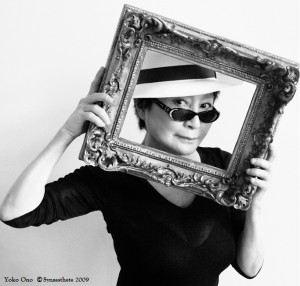 Yoko Ono has enjoyed two solo shows at the Bob Rauschenberg Gallery. The first took place from January through March of 2014. This was followed by a smaller exhibition featuring Yoko’s Wish Tree that occurred as part of ELEVEN: The John Erickson Museum of Art (JEMA) 10-Year Retrospective that went on view in the Gallery on May 9, 2014. Articles on these Yoko Ono Imagine Peace exhibitions follow:
Yoko Ono has enjoyed two solo shows at the Bob Rauschenberg Gallery. The first took place from January through March of 2014. This was followed by a smaller exhibition featuring Yoko’s Wish Tree that occurred as part of ELEVEN: The John Erickson Museum of Art (JEMA) 10-Year Retrospective that went on view in the Gallery on May 9, 2014. Articles on these Yoko Ono Imagine Peace exhibitions follow:
* * * * * * * * * * * * * * * * * * * * * * * * * * * * * * * * * * * * * * * * * * *
Imagine Peace Tower lit last night in remembrance of children killed in Israeili-Palestinian conflict (08-08-14)
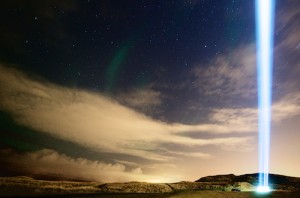 Last night, Yoko Ono Lennon requested that the Imagine Peace Tower be lit in remembrance of the children who have lost their lives in the Israeli/Palestinian conflict. In so doing, she expressed hope that the ceasefire will continue indefinitely, and that no more innocent children will be harmed.
Last night, Yoko Ono Lennon requested that the Imagine Peace Tower be lit in remembrance of the children who have lost their lives in the Israeli/Palestinian conflict. In so doing, she expressed hope that the ceasefire will continue indefinitely, and that no more innocent children will be harmed.
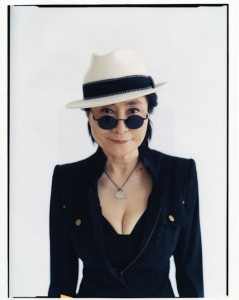 “Dear Friends,” Yoko posted last night, “As all of us are devastated by the loss of so many lives of innocent children in the Israeli/Palestinian conflict, I will be lighting IMAGINE PEACE TOWER tonight, Thursday 7th August, hoping that the ceasefire will continue indefinitely, and no more innocent children will be harmed. With deep sadness and love,”
“Dear Friends,” Yoko posted last night, “As all of us are devastated by the loss of so many lives of innocent children in the Israeli/Palestinian conflict, I will be lighting IMAGINE PEACE TOWER tonight, Thursday 7th August, hoping that the ceasefire will continue indefinitely, and no more innocent children will be harmed. With deep sadness and love,” 
The Imagine Peace Tower is a light tower located on Videy Island in Kollafjörður Bay near Reykjavík that soars two and one-half miles into the sky on a clear Icelandic night. Erected by Yoko Ono in 2006-7, 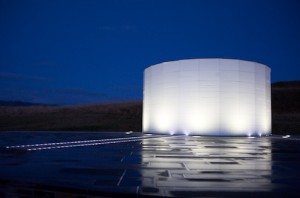 it is conjured by 15 searchlights with prisms that act as mirrors, reflecting a column of light vertically into the sky from a 30-foot wide wishing well basePower for the lights is provided by Iceland’s unique geo-thermal energy grid. It uses approximately 75 kW of power. Written on the tower’s base in 24 languages are the words “Imagine Peace,” an abbreviated slogan that traces its origins to the “War Is Over! If You Want It” billboards that she and husband John Lennon erected in cities around the world during their successful Year of Peace campaign to end the war in Vietnam.
it is conjured by 15 searchlights with prisms that act as mirrors, reflecting a column of light vertically into the sky from a 30-foot wide wishing well basePower for the lights is provided by Iceland’s unique geo-thermal energy grid. It uses approximately 75 kW of power. Written on the tower’s base in 24 languages are the words “Imagine Peace,” an abbreviated slogan that traces its origins to the “War Is Over! If You Want It” billboards that she and husband John Lennon erected in cities around the world during their successful Year of Peace campaign to end the war in Vietnam.
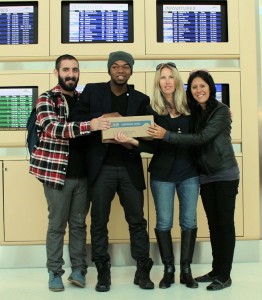 Fort Myers has a close connection with the Imagine Peace Tower. On March 12, Josue’ Charles, Christopher Lacoste and Leila Mesdaghi together with Florida SouthWestern State College Visual Arts Professor Dana Roes left Fort Myers International Airport bound for Iceland with a box containing wishes for peace that were harvested from two Wish Trees that were included in Yoko Ono Imagine Peace, a exhibition of the conceptual artist’s groundbreaking work that was on display in the Bob Rauschenberg Gallery from January 24 through March 29, 2014. Those wishes join more than a million others that Yoko has placed in time capsules in the base of the tower that have been collected by the artist from her Wish Trees since the early 1990s.
Fort Myers has a close connection with the Imagine Peace Tower. On March 12, Josue’ Charles, Christopher Lacoste and Leila Mesdaghi together with Florida SouthWestern State College Visual Arts Professor Dana Roes left Fort Myers International Airport bound for Iceland with a box containing wishes for peace that were harvested from two Wish Trees that were included in Yoko Ono Imagine Peace, a exhibition of the conceptual artist’s groundbreaking work that was on display in the Bob Rauschenberg Gallery from January 24 through March 29, 2014. Those wishes join more than a million others that Yoko has placed in time capsules in the base of the tower that have been collected by the artist from her Wish Trees since the early 1990s.
To find out more about IMAGINE PEACE TOWER, go to http://IMAGINEPEACETOWER.com/
________________________________________________________________________________
Conceptual artist Yoko Ono enjoys second solo show of 2014 at Bob Rauschenberg Gallery (05-18-14)
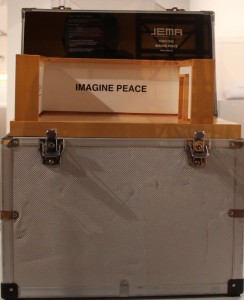 On view now through July 25 at the Bob Rauschenberg Gallery is ELEVEN: The John Erickson Museum of Art (JEMA) 10-Year Retrospective. Most of JEMA’s galleries are housed in a series of sturdy but stylish 16″x12″x9″ aluminum carrying cases. However, there are several innovative “project spaces” that have escaped their crates. One is Yoko Ono Imagine Peace, the conceptual artist’s second solo exhibition at the Bob Rauschenberg this year!
On view now through July 25 at the Bob Rauschenberg Gallery is ELEVEN: The John Erickson Museum of Art (JEMA) 10-Year Retrospective. Most of JEMA’s galleries are housed in a series of sturdy but stylish 16″x12″x9″ aluminum carrying cases. However, there are several innovative “project spaces” that have escaped their crates. One is Yoko Ono Imagine Peace, the conceptual artist’s second solo exhibition at the Bob Rauschenberg this year!
Okay, the current iteration of Yoko Ono Imagine Peace takes place concurrently with solo shows by the more than two dozen artists who are taking part in the JEMA retrospective on view through July 25 at the Rauschenberg Gallery. But that’s the beauty of JEMA. 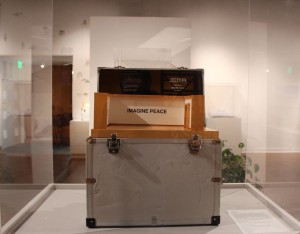 Because the work of a single artist is exhibited in a JEMA carrying case, each artist taking part in a John Erickson Museum of Art show actually enjoys their own one-person show. Which prompts Rauschenberg Gallery Director Jade Dellinger to observe that “this will be her second second solo here (ironically, with the same title) in a matter of months.” That’s the only time an artist has enjoyed nearly back to back solo shows at the Rauschenberg Gallery, a feat not likely to ever happen again.
Because the work of a single artist is exhibited in a JEMA carrying case, each artist taking part in a John Erickson Museum of Art show actually enjoys their own one-person show. Which prompts Rauschenberg Gallery Director Jade Dellinger to observe that “this will be her second second solo here (ironically, with the same title) in a matter of months.” That’s the only time an artist has enjoyed nearly back to back solo shows at the Rauschenberg Gallery, a feat not likely to ever happen again.
The current Ono solo show is drastically cut version of her earlier show, which featured such conceptual works as Imagine Peace Maps, Onochords, Mend Piece and Play It by Trust. JEMA’s Yoko Ono Imagine Peace features just one of Yoko’s works, Wish Tree.
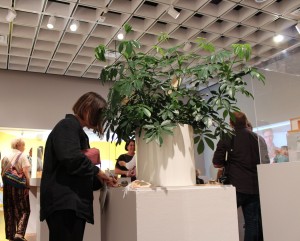 Wish Tree has been a cornerstone in Ono’s exhibitions since her introduction of the concept sometime in the early ’90s. For the JEMA retrospective, a single tree has been installed atop a pedestal inside the Bob Rauschenberg Gallery. From that promontory, the bonsai-like tree serves as a receptacle for wishes that JEMA Retrospective visitors scribble on shipping tags which they then attach to the branches of the tree. As Yoko intended, the process of conceiving, writing and attaching these personal peace prayers is a highly evocative experience that is amplified by the collective effort represented by the growing bloom of tags covering the tree.
Wish Tree has been a cornerstone in Ono’s exhibitions since her introduction of the concept sometime in the early ’90s. For the JEMA retrospective, a single tree has been installed atop a pedestal inside the Bob Rauschenberg Gallery. From that promontory, the bonsai-like tree serves as a receptacle for wishes that JEMA Retrospective visitors scribble on shipping tags which they then attach to the branches of the tree. As Yoko intended, the process of conceiving, writing and attaching these personal peace prayers is a highly evocative experience that is amplified by the collective effort represented by the growing bloom of tags covering the tree.
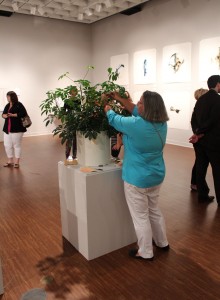 “By inviting people to make a wish and to place it on a tree branch, [Ono] compels the viewer/participant to really focus on what’s central to his/her life and determine whether this is as meaningful as it should be,” observes NY Art Examiner Daniel Gauss. “Some people have written frivolous things, some people make political statements (I saw: “Down with the patriarchy!” written on one slip) but many people express thoughts directed to others who are hungry, homeless, impoverished, suffering injustice/cruelty or in need of some type of assistance. Of course, after making the wish, the participant is also tacitly invited to question what exactly is stopping this wish from coming true. Is it political? economic? racial? Each person is invited to reflect on the extent to which he/she can and cannot take action to make this wish a reality. Each person is, in fact, invited to begin to take action again, on whatever level, to spread peace and justice throughout his/her community.”
“By inviting people to make a wish and to place it on a tree branch, [Ono] compels the viewer/participant to really focus on what’s central to his/her life and determine whether this is as meaningful as it should be,” observes NY Art Examiner Daniel Gauss. “Some people have written frivolous things, some people make political statements (I saw: “Down with the patriarchy!” written on one slip) but many people express thoughts directed to others who are hungry, homeless, impoverished, suffering injustice/cruelty or in need of some type of assistance. Of course, after making the wish, the participant is also tacitly invited to question what exactly is stopping this wish from coming true. Is it political? economic? racial? Each person is invited to reflect on the extent to which he/she can and cannot take action to make this wish a reality. Each person is, in fact, invited to begin to take action again, on whatever level, to spread peace and justice throughout his/her community.”
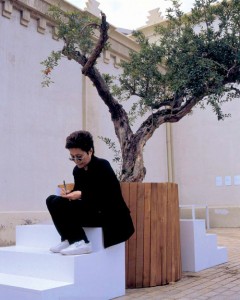 Yoko herself likens this to a collective prayer.
Yoko herself likens this to a collective prayer.
“As a child in Japan, I used to go to a temple and write out a wish on a piece of thin paper and tie it around the branch of a tree. Trees in temple courtyards were always filled with people’s wish knots, which looked like white flowers blossoming from afar,” she has explained in interviews.
Many cultures have wishing trees, where believers make votive offerings in order to gain fulfillment of their wish. For example, locals and visitors in Hong Kong write wishes on joss paper, tie them to oranges and toss them into two banyan trees known as the Lam Tsuen Wishing Trees. Legend states that if the paper sticks to one of the branches, that wish will come true. In the Loch Lomond and the Trossachs National Park Centre in Scotland, people tie their wishes for the environment to wish trees located there. In Argyll, Scotland there is a hawthorn tree where hundreds of coins have been hammered into the trunk and branches in hopes that wishes for fertility will be granted by the spirits or faeries associated with the tree. The practice of tying pieces of cloth to a wish tree is often directly associated with nearby clootie wells, as they are known in Scotland and Ireland. In a related cultural tradition found in many places, including the United States, supplicants hurl shoes into trees that are locally designated as wellsprings of good fortune.
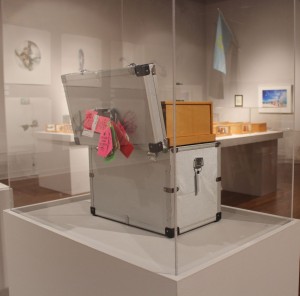 Not all of Ono’s Wish Trees are associated with larger exhibitions of her work. For example, a Wish Tree has been installed in the sculpture garden at New York’s Museum of Modern Art, with another being placed in the Hirshhorn Museum and Sculpture Garden in Washington D.C. And JEMA founder and curator took one to Ireland in 2008.
Not all of Ono’s Wish Trees are associated with larger exhibitions of her work. For example, a Wish Tree has been installed in the sculpture garden at New York’s Museum of Modern Art, with another being placed in the Hirshhorn Museum and Sculpture Garden in Washington D.C. And JEMA founder and curator took one to Ireland in 2008.
“Yoko Ono and I were in groups shows with the Indianapolis Museum of Art as well as Deitch Project Art Parade,” Miller recounts. “During some of the organizational emails for those exhibitions, I started imagining that Yoko Ono and I were probably getting the same emails. 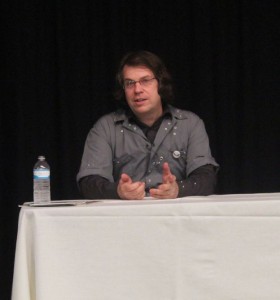 This led me to send a project proposal/invitation to Ms. Ono via the exhibition organizers. Months later, I received a very nice email expressing enthusiasm for the JEMA Show.” Around that time, JEMA was scheduled to open in Belfast, Northern Ireland with Gregory Green’s “New Free State of Caroline” project. “So Yoko Ono’s work was shown in Golden Thread Gallery but we also opened Imagine Peace at Belfast City Hall, the Peace Walls, and various other significant locations in Belfast.”
This led me to send a project proposal/invitation to Ms. Ono via the exhibition organizers. Months later, I received a very nice email expressing enthusiasm for the JEMA Show.” Around that time, JEMA was scheduled to open in Belfast, Northern Ireland with Gregory Green’s “New Free State of Caroline” project. “So Yoko Ono’s work was shown in Golden Thread Gallery but we also opened Imagine Peace at Belfast City Hall, the Peace Walls, and various other significant locations in Belfast.”
No matter where or why Wish Tree appears, the wishes that are harvested from their branches are destined for interment inside the base of the Imagine Peace Tower on Videy Island in Kollafjörður Bay near Reykjavík, Iceland.
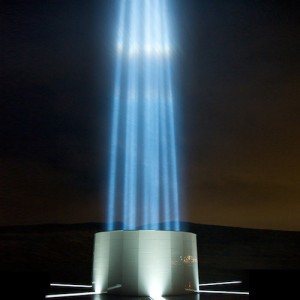 In the early days, Yoko collected the wishes herself and either took them or sent them on to Reykjavik. “I never read any of them,” she told Hans Ulrich Obrist in a 2002 interview. “I feel it’s not right to read people’s private wishes.” But now, she encourages curators and exhibitors to send their wishes directly to the Tower. In fact, the website she’s created for the tower provides both an email address (wish@imaginepeace.com) and post office box (IMAGINE PEACE TOWER, P.O.Box 1009, 121 Reykjavik, Iceland) for this very purpose.
In the early days, Yoko collected the wishes herself and either took them or sent them on to Reykjavik. “I never read any of them,” she told Hans Ulrich Obrist in a 2002 interview. “I feel it’s not right to read people’s private wishes.” But now, she encourages curators and exhibitors to send their wishes directly to the Tower. In fact, the website she’s created for the tower provides both an email address (wish@imaginepeace.com) and post office box (IMAGINE PEACE TOWER, P.O.Box 1009, 121 Reykjavik, Iceland) for this very purpose.
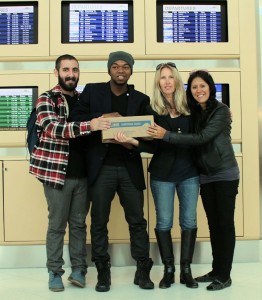 To date, the wishing-well base of the Imagine Peace Tower holds more than a million wishes from people across the globe, and a representative sample of the wishes collected during Yoko Ono Imagine Peace earlier this year were remanded into the care and custody of three Edison State students, Christopher Lacoste, Leila Mesdaghi and Josue’ Charles, along with their faculty advisor and chaperone, Professor Dana Roes, for delivery to the tower in Reykjavik. The wishes collected this go around will join those from Yoko’s earlier solo show at the Bob Rauschenberg Gallery one day in the base of the Imagine Peace Tower.
To date, the wishing-well base of the Imagine Peace Tower holds more than a million wishes from people across the globe, and a representative sample of the wishes collected during Yoko Ono Imagine Peace earlier this year were remanded into the care and custody of three Edison State students, Christopher Lacoste, Leila Mesdaghi and Josue’ Charles, along with their faculty advisor and chaperone, Professor Dana Roes, for delivery to the tower in Reykjavik. The wishes collected this go around will join those from Yoko’s earlier solo show at the Bob Rauschenberg Gallery one day in the base of the Imagine Peace Tower.
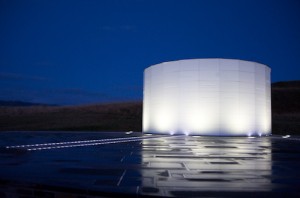 “I hope the Imagine Peace Tower will give light to the strong wishes of World Peace from all corners of the planet and give encouragement, inspiration and a sense of solidarity in a world now filled with fear and confusion,” Yoko writes on the tower’s website. “Let us come together to realize a peaceful world.”
“I hope the Imagine Peace Tower will give light to the strong wishes of World Peace from all corners of the planet and give encouragement, inspiration and a sense of solidarity in a world now filled with fear and confusion,” Yoko writes on the tower’s website. “Let us come together to realize a peaceful world.”
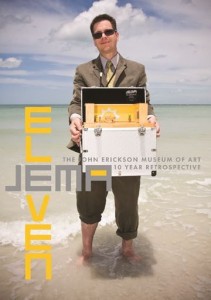 Chronicling a decade of highly innovative art projects and often unconventional installations by invited artists, ELEVEN: The John Erickson Museum of Art (JEMA) 10-Year Retrospective will mark its final day at the Bob Rauschenberg Gallery (and elucidate the enigmatic/numeric exhibition title) by closing to the public on JEMA’s ELEVENth anniversary on July 25, 2014. For more information, please visit http://www.RauschenbergGallery.com or telephone 239-489-9313.
Chronicling a decade of highly innovative art projects and often unconventional installations by invited artists, ELEVEN: The John Erickson Museum of Art (JEMA) 10-Year Retrospective will mark its final day at the Bob Rauschenberg Gallery (and elucidate the enigmatic/numeric exhibition title) by closing to the public on JEMA’s ELEVENth anniversary on July 25, 2014. For more information, please visit http://www.RauschenbergGallery.com or telephone 239-489-9313.
For more information about the Yoko Ono Imagine Peace exhibition that took place at the Bob Rauschenberg Gallery from January 24 through March 29, 2014, please visit http://www.artswfl.com/galleries/museums-art-centers/bob-rauchenburg-gallery/yoko-ono-imagine-peace/yoko-ono-imagine-peace-at-the-rauschenberg-gallery.
_______________________________________________________
With their return, individual journeys of Yoko Ono wish ambassadors now begin (04-12-14)
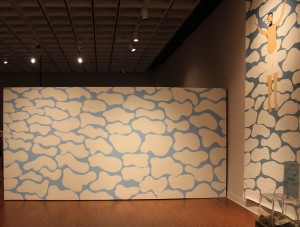 On March 12, Josue’ Charles, Christopher Lacoste and Leila Mesdaghi left Fort Myers International Airport bound for Iceland. Together with Edison State College Visual Arts Professor Dana Roes, the group was conveying a box containing wishes for peace that were harvested from two Wish Trees that were included in Yoko Ono Imagine Peace, a exhibition of the conceptual artist’s groundbreaking work that was on display in the
On March 12, Josue’ Charles, Christopher Lacoste and Leila Mesdaghi left Fort Myers International Airport bound for Iceland. Together with Edison State College Visual Arts Professor Dana Roes, the group was conveying a box containing wishes for peace that were harvested from two Wish Trees that were included in Yoko Ono Imagine Peace, a exhibition of the conceptual artist’s groundbreaking work that was on display in the 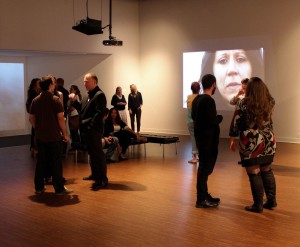 Bob Rauschenberg Gallery from January 24 through March 29, 2014. On April 10, the work Charles, Lacoste and Mesdaghi created as a result of their journey went on display at the Rauschenberg Gallery. Called ferdalag, the exhibition marks the start of each student’s personal quest to process all they saw and experienced as the college’s wish ambassadors to the Imagine Peace Tower on the tiny island of Videy outside Reykjavik.
Bob Rauschenberg Gallery from January 24 through March 29, 2014. On April 10, the work Charles, Lacoste and Mesdaghi created as a result of their journey went on display at the Rauschenberg Gallery. Called ferdalag, the exhibition marks the start of each student’s personal quest to process all they saw and experienced as the college’s wish ambassadors to the Imagine Peace Tower on the tiny island of Videy outside Reykjavik.
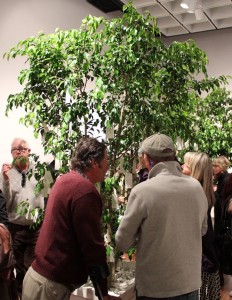 The Wish Tree is an interactive artwork that invites viewers to scribble their personal wishes for peace on shipping tags, which they then attach to the Wish Tree’s branches. Since introducing the work in the early 1990s, Yoko has collected more than one million wishes, which she periodically places in time capsules that are embedded in the base of a light tower located near Reykjavik that is an eternal tribute to her late husband, John Lennon. And, in fact, most of the wishes that Rauschenberg Gallery visitors affixed to the two ficus trees included in Yoko Ono Imagine Peace have been shipped to Yoko’s studio in New York, from whence they’ll be taken by Ono to Iceland on some future visit.
The Wish Tree is an interactive artwork that invites viewers to scribble their personal wishes for peace on shipping tags, which they then attach to the Wish Tree’s branches. Since introducing the work in the early 1990s, Yoko has collected more than one million wishes, which she periodically places in time capsules that are embedded in the base of a light tower located near Reykjavik that is an eternal tribute to her late husband, John Lennon. And, in fact, most of the wishes that Rauschenberg Gallery visitors affixed to the two ficus trees included in Yoko Ono Imagine Peace have been shipped to Yoko’s studio in New York, from whence they’ll be taken by Ono to Iceland on some future visit. 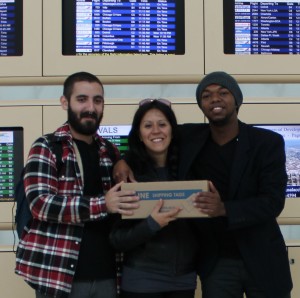 But the Bob Rauschenberg Gallery decided that three students should hand deliver a representative sample of the wishes they harvested during the exhibition and Edison State Visual Arts Professor Dana Roes was tasked with selecting the wish ambassadors who would represent the college, the gallery and all those who took the time to attach their wishes to Yoko’s Wish Trees.
But the Bob Rauschenberg Gallery decided that three students should hand deliver a representative sample of the wishes they harvested during the exhibition and Edison State Visual Arts Professor Dana Roes was tasked with selecting the wish ambassadors who would represent the college, the gallery and all those who took the time to attach their wishes to Yoko’s Wish Trees.
In Western culture, journeys presuppose both a destination and a return. But as all three wish ambassadors quickly discovered, ferdalag is more about the process of unlocking their personal creativity than a trip to and from Iceland.
“We wanted to treat [very talented students] as professional artists,” new Rauschenberg Gallery Director Jade Dellinger noted at ferdalag’s opening. “By giving them a group show in the gallery, we gave the opportunity to convert their experiences in Iceland into museum-quality fine art.”
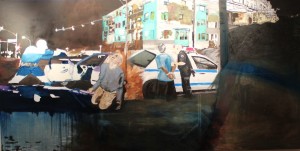 For Haitian student Josue’ Charles, the process started long before U.S. Airways Flight 721 taxied down the runway at RSW. On the way home from a meeting with Lacoste, Mesdaghi and Dana Roes to plan their impending trip, Charles was stopped and placed in handcuffs for the seemingly minor infraction of failing to wear his seat belt. Was he profiled because of the color of his skin or the country of his origin? Charles declines to speculate. But he converted his experiences that night into a highly nuanced large-scale work he appropriately titled ferdalag.
For Haitian student Josue’ Charles, the process started long before U.S. Airways Flight 721 taxied down the runway at RSW. On the way home from a meeting with Lacoste, Mesdaghi and Dana Roes to plan their impending trip, Charles was stopped and placed in handcuffs for the seemingly minor infraction of failing to wear his seat belt. Was he profiled because of the color of his skin or the country of his origin? Charles declines to speculate. But he converted his experiences that night into a highly nuanced large-scale work he appropriately titled ferdalag.
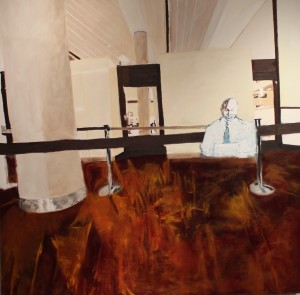 As fate would have it, Charles’ traffic stop was a harbinger of even more dire interactions with authority figures. Upon arrival in Iceland, he was ushered into an isolated waiting room where a Customs official unceremoniously informed him that because he was Haitian, he could not be admitted into the country on the basis of his passport alone. The official duly checked with his superiors to see if Josue’ could be allowed entry given the nature of his mission even though he did not have the proper visa. And while he waited for “the verdict,” Josue’ was left to wait alone, quarantined, with little else to do than study the ornate ceiling and absently eye the activity taking place just beyond the door to which he would ultimately be denied access.
As fate would have it, Charles’ traffic stop was a harbinger of even more dire interactions with authority figures. Upon arrival in Iceland, he was ushered into an isolated waiting room where a Customs official unceremoniously informed him that because he was Haitian, he could not be admitted into the country on the basis of his passport alone. The official duly checked with his superiors to see if Josue’ could be allowed entry given the nature of his mission even though he did not have the proper visa. And while he waited for “the verdict,” Josue’ was left to wait alone, quarantined, with little else to do than study the ornate ceiling and absently eye the activity taking place just beyond the door to which he would ultimately be denied access.
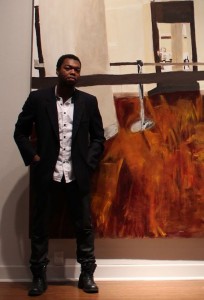 Forced to return to Fort Myers by himself, Josue’ went into seclusion. “I hid,” Josue’ confesses. “I did not want to see or talk to anyone, and I didn’t want anyone to see or talk to me.” As often happens to victims of racial profiling and those who are targeted by agencies like Homeland Security or INS, Charles internalized what had happened to him. “He was afraid that I’d be mad or would no longer want him to be part of the exhibition,” explains Dellinger, his voice rife with incredulity.
Forced to return to Fort Myers by himself, Josue’ went into seclusion. “I hid,” Josue’ confesses. “I did not want to see or talk to anyone, and I didn’t want anyone to see or talk to me.” As often happens to victims of racial profiling and those who are targeted by agencies like Homeland Security or INS, Charles internalized what had happened to him. “He was afraid that I’d be mad or would no longer want him to be part of the exhibition,” explains Dellinger, his voice rife with incredulity.
But Josue’ shed his self-doubt in the studio, producing both a painting that encapsulates his time in Icelandic Customs, as well as an untitled self-portrait that depicts the confidence and determination the artist discovered lurking deep within.
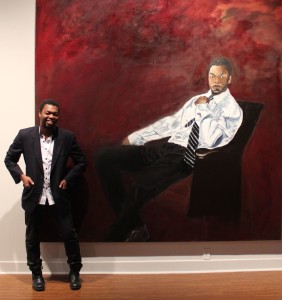 “One of the reasons I painted that room in Customs,” Josue’ declares, “is to remind myself that one day I will return to Iceland and visit the Imagine Peace Tower just like I was supposed to do.”
“One of the reasons I painted that room in Customs,” Josue’ declares, “is to remind myself that one day I will return to Iceland and visit the Imagine Peace Tower just like I was supposed to do.”
Ferdalag. A journey or voyage. A creative process of self-discovery and overcoming. Or will to power, to borrow a concept from German philosopher Frederich Nietzsche.
For Leila Mesdaghi, the journey took a much different form.
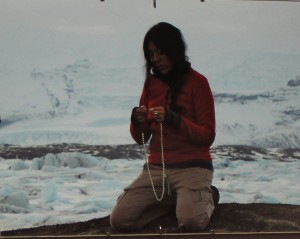 “What happened to Josue’ was heartbreaking,” she says, her voice choked with emotion. “All of us cried. We all felt terrible. But we had to go on.” From the back seat of the compact rental car crammed full of their luggage and art gear, Christopher Lacoste finally muttered, “We didn’t have room for him anyway.” As it usually does, the deadpanned humor helped Mesdaghi, Professor Roes and Lacoste get beyond the blow their mission had been dealt.
“What happened to Josue’ was heartbreaking,” she says, her voice choked with emotion. “All of us cried. We all felt terrible. But we had to go on.” From the back seat of the compact rental car crammed full of their luggage and art gear, Christopher Lacoste finally muttered, “We didn’t have room for him anyway.” As it usually does, the deadpanned humor helped Mesdaghi, Professor Roes and Lacoste get beyond the blow their mission had been dealt.
But Josue’ was far from forgotten. “Every time we saw or did something new,” says Leila, “we’d say, ‘Oh, Josue’ would have loved this,’ or ‘I wish Josue’ could see that.’”
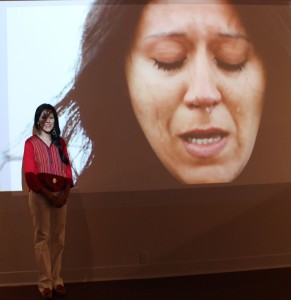 Leila had intended from the outset to lens a performance art piece during her stay in Iceland. She even brought along a chair that she’d used in a performance piece she staged at the Sidney & Berne Davis Art Center late last year. But when it came time for her to make the film, the absence of Josue’, her son, her father and the others she’d left behind came rushing to the forefront. And as she mouthed their names as she thumbed her prayer beads, giant tears cascaded down her cheeks and her nose began to run uncontrolled and unchecked, like the glaciers all around.
Leila had intended from the outset to lens a performance art piece during her stay in Iceland. She even brought along a chair that she’d used in a performance piece she staged at the Sidney & Berne Davis Art Center late last year. But when it came time for her to make the film, the absence of Josue’, her son, her father and the others she’d left behind came rushing to the forefront. And as she mouthed their names as she thumbed her prayer beads, giant tears cascaded down her cheeks and her nose began to run uncontrolled and unchecked, like the glaciers all around.
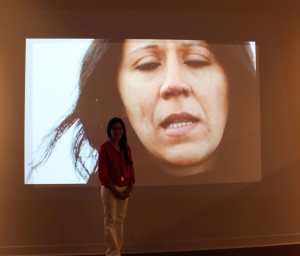 “The whole experience was just so overwhelming. So overpowering. The landscape, the sea, was so expansive and uninterrupted. There we were on top of the world, so elevated that everything else seemed so small and inconsequential. I felt such a deep sense of gratitude that it made me want to cry. Professor Roes told me to just go with the emotion. To release it. And instead of having the camera take in my entire body as I’d originally intended , she focused the lens on just my face.” Roes’ well-hewn instincts were spot on. The close up footage of a crying, runny-nosed Mesdaghi took command of the Bob Rauschenberg Gallery during ferdalag‘s opening last Thursday night.
“The whole experience was just so overwhelming. So overpowering. The landscape, the sea, was so expansive and uninterrupted. There we were on top of the world, so elevated that everything else seemed so small and inconsequential. I felt such a deep sense of gratitude that it made me want to cry. Professor Roes told me to just go with the emotion. To release it. And instead of having the camera take in my entire body as I’d originally intended , she focused the lens on just my face.” Roes’ well-hewn instincts were spot on. The close up footage of a crying, runny-nosed Mesdaghi took command of the Bob Rauschenberg Gallery during ferdalag‘s opening last Thursday night.
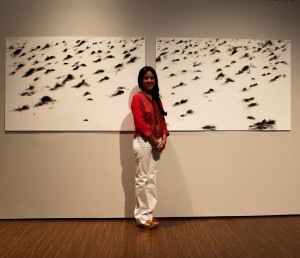 “The breakthrough for me was the creative power that comes from being in the moment,” Leila explains, unintentionally echoing the message of master entrepreneur, hip-hop mogul and New York Times bestselling author Russell Simmons, who advocates meditation as the fundamental key to living in the moment and releasing your untapped potential. As she worked her way around the length of her prayer beads, Leila never broke the immediacy of the performance, not even to wipe away a tear or the stream of mucous dripping uninterrupted over her lips in the bitter Icelandic wind and cold.
“The breakthrough for me was the creative power that comes from being in the moment,” Leila explains, unintentionally echoing the message of master entrepreneur, hip-hop mogul and New York Times bestselling author Russell Simmons, who advocates meditation as the fundamental key to living in the moment and releasing your untapped potential. As she worked her way around the length of her prayer beads, Leila never broke the immediacy of the performance, not even to wipe away a tear or the stream of mucous dripping uninterrupted over her lips in the bitter Icelandic wind and cold.
But how will she use that lesson going forward to make new and even more powerful art? Ferdalag. A journey or voyage. A creative process of self-discovery and overcoming. Or will to power, to borrow a concept from German philosopher Frederich Nietzsche.
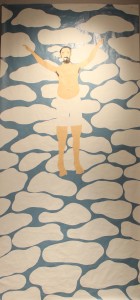 For Christopher Lacoste, the experience was also about using stillness as a powerful tool to access his own formidable creative potential – as his massive self-portrait in the entry to the exhibition clearly conveys. “I’m laying at the bottom of a pool, looking up, looking at the clouds reflected on the surface,” Christopher reveals, decoding the minimalist work. “It’s calm. Tranquil.” Like the large expanses of Icelandic coastline, mountains and steely blue glaciers.
For Christopher Lacoste, the experience was also about using stillness as a powerful tool to access his own formidable creative potential – as his massive self-portrait in the entry to the exhibition clearly conveys. “I’m laying at the bottom of a pool, looking up, looking at the clouds reflected on the surface,” Christopher reveals, decoding the minimalist work. “It’s calm. Tranquil.” Like the large expanses of Icelandic coastline, mountains and steely blue glaciers.
“Much of the terrain was barren white,” Chris reports. “But the ice and water was tinged with this icy blue color.” And that color not only appears in his self-portrait, but in the immense glaciers he created from rolls of plastic and backlighted with blue light to replicate the chilly specter he found so pervasive as he, Mesdaghi and Dana Roes traversed the countryside during their forays through the island.
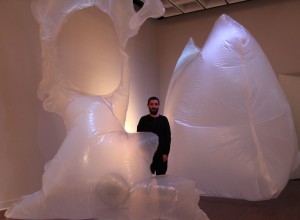 But while cultural enrichment, inspiration and heightened creativity were always integral parts of Charles, Mesdaghi and Lacost’s ferdalag, the overarching objective of the trip to Iceland remained the delivery of Southwest Florida’s wishes to the Imagine Peace Tower. And to draw a non-Beatles analogy to Deep Purples’ Smoke on the Water, it seemed for awhile that nature had other plans. “The morning after we arrived, we were supposed to take the ferry to Videy Island to deliver the wishes to the Tower,” Dana Roes explained during the ferdalag reception. “But a 35 mile-per-hour wind churned up the bay and the cold was so bitter the ferry company had to cancel the trip. And when we returned on Monday, the weather was just as bad.” Icelandic time was running out, and it seemed that Roes, Mesdaghi and Lacoste would lose the race.
But while cultural enrichment, inspiration and heightened creativity were always integral parts of Charles, Mesdaghi and Lacost’s ferdalag, the overarching objective of the trip to Iceland remained the delivery of Southwest Florida’s wishes to the Imagine Peace Tower. And to draw a non-Beatles analogy to Deep Purples’ Smoke on the Water, it seemed for awhile that nature had other plans. “The morning after we arrived, we were supposed to take the ferry to Videy Island to deliver the wishes to the Tower,” Dana Roes explained during the ferdalag reception. “But a 35 mile-per-hour wind churned up the bay and the cold was so bitter the ferry company had to cancel the trip. And when we returned on Monday, the weather was just as bad.” Icelandic time was running out, and it seemed that Roes, Mesdaghi and Lacoste would lose the race.
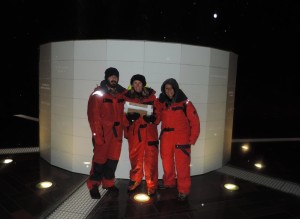 “But they gave us snowmobile jumpsuits and took us over to the island anyway,” Roes reported. “Of course, there was really no place on the island to leave our box of wishes, but we located the post office box where the wishes are mailed. So in the end, Chris and Leila were able to deliver the wishes, which Yoko will presumably place in a time capsule in the base of the tower on her next trip.” In fact, if the trip had occurred a week earlier, the group may have run into Ono. “She was there four days earlier. With the hats that she wears, she’s hard to miss.”
“But they gave us snowmobile jumpsuits and took us over to the island anyway,” Roes reported. “Of course, there was really no place on the island to leave our box of wishes, but we located the post office box where the wishes are mailed. So in the end, Chris and Leila were able to deliver the wishes, which Yoko will presumably place in a time capsule in the base of the tower on her next trip.” In fact, if the trip had occurred a week earlier, the group may have run into Ono. “She was there four days earlier. With the hats that she wears, she’s hard to miss.”
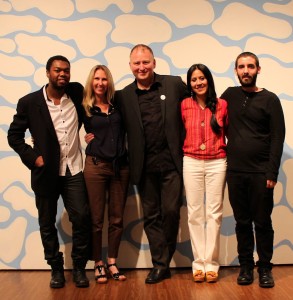 But for all the satisfaction that she personally derived from accomplishing their mission, Roes is even more pleased with the work that Charles, Mesdaghi and Lacoste were able to complete for the exhibition. “The integrity of the work is extraordinary,” Professor Roes shares. “It’s well-digested. It evinces a maturity that’s just remarkable.”
But for all the satisfaction that she personally derived from accomplishing their mission, Roes is even more pleased with the work that Charles, Mesdaghi and Lacoste were able to complete for the exhibition. “The integrity of the work is extraordinary,” Professor Roes shares. “It’s well-digested. It evinces a maturity that’s just remarkable.”
You, too, can experience that maturity by visiting the Bob Rauschenberg Gallery prior to April 24. Ferdalag can be seen during normal gallery hours. The gallery is open 10 a.m. to 4 p.m. Monday through Friday, and 11 a.m. to 3 p.m.
on Saturday (closed Sundays and holidays). For more information, please telephone 239-489-9313.
___________________________________________
Edison State ‘wish ambassadors’ leave for Iceland with wishes of peace and love (03-15-14)
 Edison State College art students, Josue’ Charles, Christopher Lacoste and Leila Mesdaghi flew out of Fort Myers International Airport on Wednesday bound for Reykjavik, Iceland. Calling themselves Fort Myers’ Wish Ambassadors, they had with them a box of wishes for world and personal peace collected by the Bob Rauschenberg Gallery since the opening of Yoko Ono Imagine Peace on January 24.
Edison State College art students, Josue’ Charles, Christopher Lacoste and Leila Mesdaghi flew out of Fort Myers International Airport on Wednesday bound for Reykjavik, Iceland. Calling themselves Fort Myers’ Wish Ambassadors, they had with them a box of wishes for world and personal peace collected by the Bob Rauschenberg Gallery since the opening of Yoko Ono Imagine Peace on January 24.
The Wish Tree has been a cornerstone in Yoko Ono’s exhibitions since her introduction of the concept sometime in the early ’90s. So not surprisingly, Yoko Ono Imagine Peace curators Kevin Concannon and John Noga included Wish Tree in the Yoko Ono exhibition they brought to Fort Myers in January. 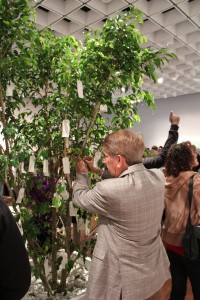 Since then, gallery visitors have scribbled their personal wishes for peace on shipping tags which they’ve then attached to the branches of two ficus trees. The gallery has periodically harvested the tags to make room for new wishes, and the majority of these wishes will be delivered to Yoko Ono’s studio in New York, where they’ll eventually join thousands of others on Yoko’s next trip to Iceland. There, she will place them in one or more time capsules in the base of the Imagine Peace Tower on Videy Island outside Reykjavik. But the Bob Rauschenberg Gallery decided that three Edison State student should hand deliver a representative sample of the wishes they’ve collected directly to the tower, and Edison State Visual Arts Teacher Dana Roes hand selected Josue’ Charles, Christopher Lacoste and Leila Mesdaghi for this honor.
Since then, gallery visitors have scribbled their personal wishes for peace on shipping tags which they’ve then attached to the branches of two ficus trees. The gallery has periodically harvested the tags to make room for new wishes, and the majority of these wishes will be delivered to Yoko Ono’s studio in New York, where they’ll eventually join thousands of others on Yoko’s next trip to Iceland. There, she will place them in one or more time capsules in the base of the Imagine Peace Tower on Videy Island outside Reykjavik. But the Bob Rauschenberg Gallery decided that three Edison State student should hand deliver a representative sample of the wishes they’ve collected directly to the tower, and Edison State Visual Arts Teacher Dana Roes hand selected Josue’ Charles, Christopher Lacoste and Leila Mesdaghi for this honor.
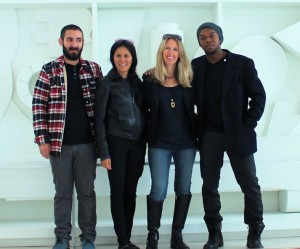 “They are such outstanding students that I was already in the process of planning a group show in the gallery that features their individual and collective work,” noted Roes, who is accompanying Charles, Lacoste and Mesdaghi on their sojourn to Iceland. “So when the Iceland trip came up, it was only natural to choose them to go.”
“They are such outstanding students that I was already in the process of planning a group show in the gallery that features their individual and collective work,” noted Roes, who is accompanying Charles, Lacoste and Mesdaghi on their sojourn to Iceland. “So when the Iceland trip came up, it was only natural to choose them to go.”
But their connection with Yoko Ono Imagine Peace runs deeper. Josue’, Christopher and Leila were on hand at the opening to provide instruction to visitors on how to assemble the broken globe that is at the core of Yoko’s Mend Piece. 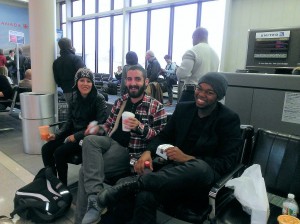 And, of course, all three wrote out and attached their own wishes to the branches of the Wish Trees. But none would reveal what their wishes are. “That would be bad luck,” observes Mesdaghi, who notes that Yoko herself never reads the wishes that are sent to her for inclusion in the base of the Imagine Peace Tower.
And, of course, all three wrote out and attached their own wishes to the branches of the Wish Trees. But none would reveal what their wishes are. “That would be bad luck,” observes Mesdaghi, who notes that Yoko herself never reads the wishes that are sent to her for inclusion in the base of the Imagine Peace Tower.
“I hope that whatever [the exhibition’s attendees] wrote on the paper comes true,” said Charles hefting the box of wishes in one hand. “I feel like we’re ambassadors of peace and love, and feel very honored and fortunate to be able to deliver the messages” Mesdaghi added with obvious reverence.
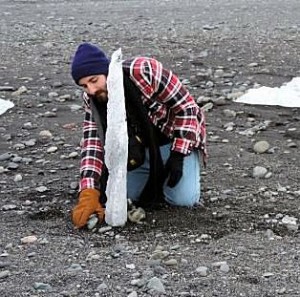 All three students had messages for Yoko as well. “I’m very grateful for all she’s done,” said Lacoste. “Her message is so positive and so much good has come from her.”
All three students had messages for Yoko as well. “I’m very grateful for all she’s done,” said Lacoste. “Her message is so positive and so much good has come from her.”
“We have a show in her space, and we’re hoping to expand her message in our own show,” Mesdaghi chimed in.
“I just wish we could meet her in Iceland,” Josue’ Charles quipped, a wide smile claiming the corners of his mouth.
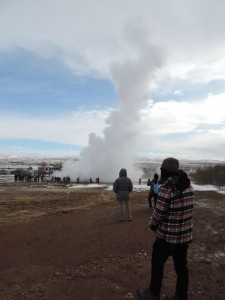 Roes and her three students all appreciate the magnitude of the opportunity they’ve been given to have a group show at a venue as prestigious as the Bob Rauschenberg Gallery. Since the opening is just a scant two weeks from the date they return, the trio does not have the luxury to wait until they’re back in Southwest Florida to start creating the work that will be included in the show. “We’ve been creating work since we learned about the trip six weeks ago,” Charles noted. “And we intend to create individual and collective pieces while we’re in Iceland,” said Mesdaghi, who confessed that nascent ideas are still bubbling up from both her conscious and unconscious mind.
Roes and her three students all appreciate the magnitude of the opportunity they’ve been given to have a group show at a venue as prestigious as the Bob Rauschenberg Gallery. Since the opening is just a scant two weeks from the date they return, the trio does not have the luxury to wait until they’re back in Southwest Florida to start creating the work that will be included in the show. “We’ve been creating work since we learned about the trip six weeks ago,” Charles noted. “And we intend to create individual and collective pieces while we’re in Iceland,” said Mesdaghi, who confessed that nascent ideas are still bubbling up from both her conscious and unconscious mind.
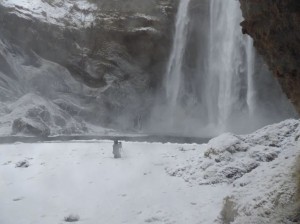 “It’s going to be experiential, so as things unfold, we hope we have everything we need [to create intriguing artworks],” related Roes who, as an internationally-renowned artist in her own right fully understands the creative process and the demands of putting together a world-class show.
“It’s going to be experiential, so as things unfold, we hope we have everything we need [to create intriguing artworks],” related Roes who, as an internationally-renowned artist in her own right fully understands the creative process and the demands of putting together a world-class show.
The Imagine Peace Tower is a light tower located on Videy Island in Kollafjörður Bay near Reykjavík that soars two and one-half miles into the sky on a clear Icelandic night. 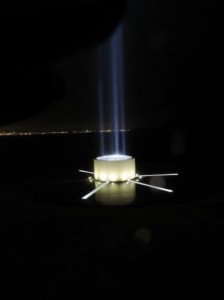 Erected by Yoko Ono in 2006-7, it is conjured by 15 searchlights with prisms that act as mirrors, reflecting a column of light vertically into the sky from a 30-foot wide wishing well base that contains time capsules that hold more than a million wishes harvested from Ono’s Wish Trees since she first introduced the installation in the early 1990s. The students will be in Iceland for seven days. Their group show at the Bob Rauschenberg Gallery opens on April 10.
Erected by Yoko Ono in 2006-7, it is conjured by 15 searchlights with prisms that act as mirrors, reflecting a column of light vertically into the sky from a 30-foot wide wishing well base that contains time capsules that hold more than a million wishes harvested from Ono’s Wish Trees since she first introduced the installation in the early 1990s. The students will be in Iceland for seven days. Their group show at the Bob Rauschenberg Gallery opens on April 10.
If you want your personal wish for peace to be included with those taken by the Edison State College delegation to Reyjkavik, you have until March 29 to visit Yoko Ono Imagine Peace at the Bob Rauschenberg Gallery on the Lee campus of Edison State College. During the exhibit, gallery hours are 10 a.m. to 4 p.m. Monday through Friday, and 11 a.m. to 3 p.m. on Saturday (closed Sundays and holidays). For more information, please telephone 239-489-9313.
________________________________________________________
Three Edison State students chosen to deliver Wish Tree wishes to Imagine Peace Tower in Iceland (03-17-14)
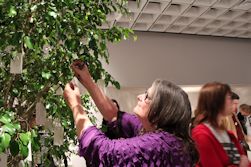 Wish Tree has been a cornerstone in Yoko Ono’s exhibitions since her introduction of the concept sometime in the early ’90s. So not surprisingly, co-curators Kevin Concannon and John Noga placed two ficus trees inside the Bob Rauschenberg Gallery as receptacles for wishes scribbled by Yoko Ono Imagine Peace visitors on shipping tags they’ve provided for that purpose. Since the opening of the exhibition on January 24, thousands of guests have attached their written wishes to the branches of the two trees, and now those wishes are being transported to the Imagine Peace Tower in Reyjkavik, Iceland by three Edison State College art students, Josue’ Charles, Christopher Lacoste and Leila Mesdaghi.
Wish Tree has been a cornerstone in Yoko Ono’s exhibitions since her introduction of the concept sometime in the early ’90s. So not surprisingly, co-curators Kevin Concannon and John Noga placed two ficus trees inside the Bob Rauschenberg Gallery as receptacles for wishes scribbled by Yoko Ono Imagine Peace visitors on shipping tags they’ve provided for that purpose. Since the opening of the exhibition on January 24, thousands of guests have attached their written wishes to the branches of the two trees, and now those wishes are being transported to the Imagine Peace Tower in Reyjkavik, Iceland by three Edison State College art students, Josue’ Charles, Christopher Lacoste and Leila Mesdaghi.
 The Imagine Peace Tower is a light tower located on Videy Island in Kollafjörður Bay near Reykjavík that soars two and one-half miles into the sky on a clear Icelandic night. Erected by Yoko Ono in 2006-7, it is conjured by 15 searchlights with prisms that act as mirrors, reflecting a column of light vertically into the sky from a 30-foot wide wishing well base that contains time capsules that hold more than a million wishes harvested from Ono’s Wish Trees since she first introduced the installation in the early 1990s.
The Imagine Peace Tower is a light tower located on Videy Island in Kollafjörður Bay near Reykjavík that soars two and one-half miles into the sky on a clear Icelandic night. Erected by Yoko Ono in 2006-7, it is conjured by 15 searchlights with prisms that act as mirrors, reflecting a column of light vertically into the sky from a 30-foot wide wishing well base that contains time capsules that hold more than a million wishes harvested from Ono’s Wish Trees since she first introduced the installation in the early 1990s.
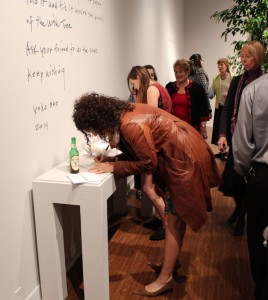 In the early days, Yoko plucked the wishes from her Wish Trees herself and took them personally to Reykjavik. “I never read any of them,” she told Hans Ulrich Obrist in a 2002 interview. “I feel it’s not right to read people’s private wishes.” But at 81, she now encourages curators and exhibitors to send their wishes directly to the Tower and has provided both an email address and post office box in Reykjavik for that very purpose. But new Bob Rauschenberg Gallery Director Jade Dellinger thought it would be more meaningful for everyone concerned to have three Edison State students fly a representative sample of wishes to the Imagine Peace Tower on Videy Island.
In the early days, Yoko plucked the wishes from her Wish Trees herself and took them personally to Reykjavik. “I never read any of them,” she told Hans Ulrich Obrist in a 2002 interview. “I feel it’s not right to read people’s private wishes.” But at 81, she now encourages curators and exhibitors to send their wishes directly to the Tower and has provided both an email address and post office box in Reykjavik for that very purpose. But new Bob Rauschenberg Gallery Director Jade Dellinger thought it would be more meaningful for everyone concerned to have three Edison State students fly a representative sample of wishes to the Imagine Peace Tower on Videy Island.
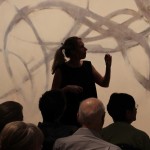 Josue’ Charles, Christopher Lacoste and Leila Mesdaghi were selected for the honor by Edison State College Art Instructor Dana Roes on the basis of merit. “All three are exceptional art students,” notes Dellinger, ” who adds that Dr. Roes will accompany the students on their trip. She spent a year in Iceland on a Fulbright scholarship that culminated in an exhibition of her series, The Red Body, at the Gallery Listamidstodim.
Josue’ Charles, Christopher Lacoste and Leila Mesdaghi were selected for the honor by Edison State College Art Instructor Dana Roes on the basis of merit. “All three are exceptional art students,” notes Dellinger, ” who adds that Dr. Roes will accompany the students on their trip. She spent a year in Iceland on a Fulbright scholarship that culminated in an exhibition of her series, The Red Body, at the Gallery Listamidstodim.
Following their return, Charles, Lacoste and Mesdaghi will collaborate on a group show in the 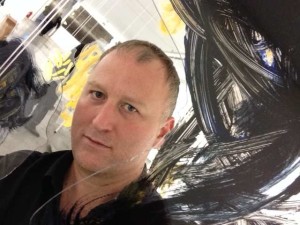 Bob Rauschenberg Gallery that opens April 10. Ferdalag (a journey or voyage), will include individual and collaborative artworks inspired by Yoko Ono Imagine Peace and the experiences they gain while visiting Iceland. “The important part for the Rauschenberg Gallery is to help these deserving students excel and give them a meaningful opportunity to learn about professional practices,” adds Dellinger.
Bob Rauschenberg Gallery that opens April 10. Ferdalag (a journey or voyage), will include individual and collaborative artworks inspired by Yoko Ono Imagine Peace and the experiences they gain while visiting Iceland. “The important part for the Rauschenberg Gallery is to help these deserving students excel and give them a meaningful opportunity to learn about professional practices,” adds Dellinger.
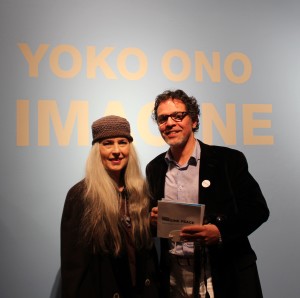 If you want your personal wish for peace to be included with those taken by the Edison State College delegation to Reyjkavik, you have until March 29 to visit Yoko Ono Imagine Peace at the Bob Rauschenberg Gallery on the Lee campus of Edison State College. During the exhibit, gallery hours are 10 a.m. to 4 p.m. Monday through Friday, and 11 a.m. to 3 p.m. on Saturday (closed Sundays and holidays). For more information, please telephone 239-489-9313.
If you want your personal wish for peace to be included with those taken by the Edison State College delegation to Reyjkavik, you have until March 29 to visit Yoko Ono Imagine Peace at the Bob Rauschenberg Gallery on the Lee campus of Edison State College. During the exhibit, gallery hours are 10 a.m. to 4 p.m. Monday through Friday, and 11 a.m. to 3 p.m. on Saturday (closed Sundays and holidays). For more information, please telephone 239-489-9313.
“All my works are a form of wishing,” notes the artist. “Keep wishing while you participate.”
_______________________________________________________________
Yoko Ono ‘Imagine Peace Maps’ are visualization tool for imagining world and personal peace (01-29-14)
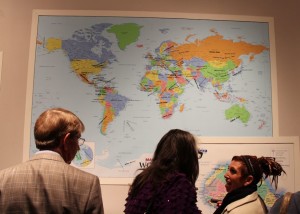 Yoko Ono has been advocating for peace through art and activism for half a century, and yet it’s hard to imagine a spot on the globe where peace and love reign supreme. Afghanistan, Algeria, the Basque region of northern Spain, Burma (site of the world’s longest and most complex ethnic conflict), Burundi, Columbia, Congo, Chechnya, Gaza, Iran, Iraq, Israel,
Yoko Ono has been advocating for peace through art and activism for half a century, and yet it’s hard to imagine a spot on the globe where peace and love reign supreme. Afghanistan, Algeria, the Basque region of northern Spain, Burma (site of the world’s longest and most complex ethnic conflict), Burundi, Columbia, Congo, Chechnya, Gaza, Iran, Iraq, Israel, 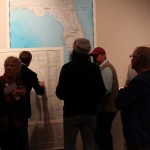 the Ivory Coast, Kashmir, Lebanon, Nepal, North Korea, Palestine, Rwanda, Sri Lanka, Sudan and Syria are just the biggest, latest and most volatile hot spots and war zones on the planet. But many, perhaps most, of the 896 people attending the opening of Yoko Ono Imagine Peace at the Bob Rauschenberg Gallery on January 24 bypassed these locales, opting instead to stamp the words “Imagine Peace” on places within the United States, Florida and right here in Lee County.
the Ivory Coast, Kashmir, Lebanon, Nepal, North Korea, Palestine, Rwanda, Sri Lanka, Sudan and Syria are just the biggest, latest and most volatile hot spots and war zones on the planet. But many, perhaps most, of the 896 people attending the opening of Yoko Ono Imagine Peace at the Bob Rauschenberg Gallery on January 24 bypassed these locales, opting instead to stamp the words “Imagine Peace” on places within the United States, Florida and right here in Lee County.
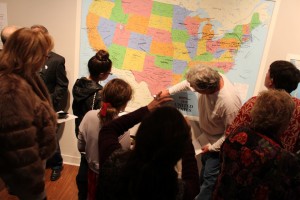 Which is exactly as the artist envisioned. Ono’s Imagine Peace Maps installation doesn’t impose any strictures or mandates on those who interact with it. Yoko merely provides maps, rubber stamps and ink pads. It’s then up to the viewer to engage the participatory piece in whatever manner they wish.
Which is exactly as the artist envisioned. Ono’s Imagine Peace Maps installation doesn’t impose any strictures or mandates on those who interact with it. Yoko merely provides maps, rubber stamps and ink pads. It’s then up to the viewer to engage the participatory piece in whatever manner they wish.
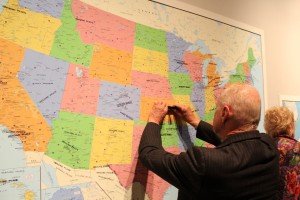 For example, neither the artist nor the art installation impose any definition of the word peace. Last Friday night, some people chose to stamp obvious sites such as Afghanistan, Iran and North Korea. But others inked places like New Town, Aurora, Scottsdale, Columbine, Virginia Tech and Detroit, where gun violence has torn at the fabric of American society and
For example, neither the artist nor the art installation impose any definition of the word peace. Last Friday night, some people chose to stamp obvious sites such as Afghanistan, Iran and North Korea. But others inked places like New Town, Aurora, Scottsdale, Columbine, Virginia Tech and Detroit, where gun violence has torn at the fabric of American society and 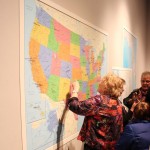 embroiled citizens and politicians in an on-going argument over gun rights, civil rights and more effective treatment for people facing mental health challenges. Others chose their own homes and hometowns, opting to conflate peace with inner harmony, balance or even freedom from domestic violence.
embroiled citizens and politicians in an on-going argument over gun rights, civil rights and more effective treatment for people facing mental health challenges. Others chose their own homes and hometowns, opting to conflate peace with inner harmony, balance or even freedom from domestic violence.
But where the stamp landed wasn’t really the point of the exercise. “I lost my best bud there,” a thready voice informed, referring to a shooting victim who died in a town like any other in America. “Three guys in my unit were killed here by an IED (improvised explosive device),” 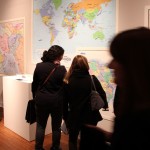 said another, pointing solemnly to bit of arid, rocky terrain somewhere in the Middle East. My brother. My son. My wife. My mom. So many in last Friday night’s crowd had lost loved ones to war, gun, domestic and other forms of violence, and that dawning realization converted what started out for most as a purely personal experience into a group phenomenon. We’re not alone. We’re all affected. Imagine peace. Imagine the contributions the lost would have made to our lives had there been peace ….
said another, pointing solemnly to bit of arid, rocky terrain somewhere in the Middle East. My brother. My son. My wife. My mom. So many in last Friday night’s crowd had lost loved ones to war, gun, domestic and other forms of violence, and that dawning realization converted what started out for most as a purely personal experience into a group phenomenon. We’re not alone. We’re all affected. Imagine peace. Imagine the contributions the lost would have made to our lives had there been peace ….
Ono’s pieces work that way. They evoke powerful emotions, be it loss, sadness, hope or determination. 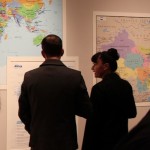 The latter also best describes the artist herself. Although world peace remains as elusive as ever, Ono continues to urge her fans, 4.5 million Twitter followers and people new to her work and political activism to continue to imagine peace. She operates from a place of unyielding, unshakable conviction that if enough people imagine peace long enough, their commonly-held dream will one day become a global reality. Visualizing creates that reality, and her Imagine Peace Maps is a powerful tool for enabling people to envision peace in places where people presently only see conflict.
The latter also best describes the artist herself. Although world peace remains as elusive as ever, Ono continues to urge her fans, 4.5 million Twitter followers and people new to her work and political activism to continue to imagine peace. She operates from a place of unyielding, unshakable conviction that if enough people imagine peace long enough, their commonly-held dream will one day become a global reality. Visualizing creates that reality, and her Imagine Peace Maps is a powerful tool for enabling people to envision peace in places where people presently only see conflict.
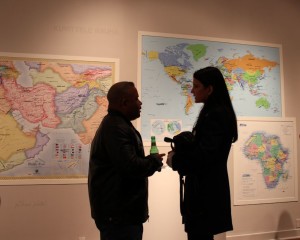 It’s a powerful psychic principle. But to experience it, you have to place your own stamp on the map. Yoko Ono Imagine Peace is on view now through March 29 at the Bob Rauschenberg Gallery on the Lee campus of Edison State College. During the exhibit, gallery hours are 10 a.m. to 4 p.m. Monday through Friday, and 11 a.m. to 3 p.m. on Saturday (closed Sundays and holidays). For more information, please telephone 239-489-9313.
It’s a powerful psychic principle. But to experience it, you have to place your own stamp on the map. Yoko Ono Imagine Peace is on view now through March 29 at the Bob Rauschenberg Gallery on the Lee campus of Edison State College. During the exhibit, gallery hours are 10 a.m. to 4 p.m. Monday through Friday, and 11 a.m. to 3 p.m. on Saturday (closed Sundays and holidays). For more information, please telephone 239-489-9313.
“All my works are a form of wishing,” notes the artist. “Keep wishing while you participate.”
______________________________________________________________
Fort Myers’ wishes for peace to be added to Imagine Peace Tower in Iceland (01-27-14)
 Yoko Ono Imagine Peace opened January 24 at the Bob Rauschenberg Gallery in Fort Myers. While each of the works included in the show are highly interactive, Ono’s Wish Tree involves participants on multiple psycho-social levels.
Yoko Ono Imagine Peace opened January 24 at the Bob Rauschenberg Gallery in Fort Myers. While each of the works included in the show are highly interactive, Ono’s Wish Tree involves participants on multiple psycho-social levels.
Wish Tree has been a cornerstone in Ono’s exhibitions since her introduction of the concept sometime in the early ’90s, and so 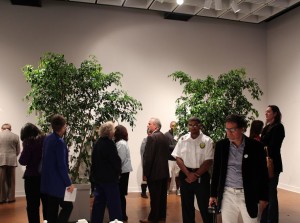 co-curators Kevin Concannon and John Noga and Director Jade Dellinger installed two ficus trees inside the Bob Rauschenberg Gallery to serve as receptacles for wishes scribbled by visitors on shipping tags that have been provided for that purpose. Virtually every one of the 896 people who attended last Friday night’s opening reception took the time to attach their written wish to a branch. As Yoko intended, most were visibly affected, not only by the exercise of formulating and writing out their personal wish for peace, but by the collective effort codified by the growing bloom of tags covering each tree.
co-curators Kevin Concannon and John Noga and Director Jade Dellinger installed two ficus trees inside the Bob Rauschenberg Gallery to serve as receptacles for wishes scribbled by visitors on shipping tags that have been provided for that purpose. Virtually every one of the 896 people who attended last Friday night’s opening reception took the time to attach their written wish to a branch. As Yoko intended, most were visibly affected, not only by the exercise of formulating and writing out their personal wish for peace, but by the collective effort codified by the growing bloom of tags covering each tree.
 “By inviting people to make a wish and to place it on a tree branch, [Ono] compels the viewer/participant to really focus on what’s central to his/her life and determine whether this is as meaningful as it should be,” observes NY Art Examiner Daniel Gauss. “Some people have written frivolous things, some people make political statements (I saw: “Down with the patriarchy!” written on one slip) but many people express thoughts directed to others who are hungry, homeless, impoverished, suffering injustice/cruelty or in need of some type of assistance. Of course, after making the wish, the participant is also tacitly invited to question what exactly is stopping this wish from coming true.
“By inviting people to make a wish and to place it on a tree branch, [Ono] compels the viewer/participant to really focus on what’s central to his/her life and determine whether this is as meaningful as it should be,” observes NY Art Examiner Daniel Gauss. “Some people have written frivolous things, some people make political statements (I saw: “Down with the patriarchy!” written on one slip) but many people express thoughts directed to others who are hungry, homeless, impoverished, suffering injustice/cruelty or in need of some type of assistance. Of course, after making the wish, the participant is also tacitly invited to question what exactly is stopping this wish from coming true.  Is it political? economic? racial? Each person is invited to reflect on the extent to which he/she can and cannot take action to make this wish a reality. Each person is, in fact, invited to begin to take action again, on whatever level, to spread peace and justice throughout his/her community.”
Is it political? economic? racial? Each person is invited to reflect on the extent to which he/she can and cannot take action to make this wish a reality. Each person is, in fact, invited to begin to take action again, on whatever level, to spread peace and justice throughout his/her community.”
Yoko herself likens this to a collective prayer. “As a child in Japan, I used to go to a temple and write out a wish on a piece of thin paper and tie it around the branch of a tree. Trees in temple courtyards were always filled with people’s wish knots, which looked like white flowers blossoming from afar,” she has explained in interviews.
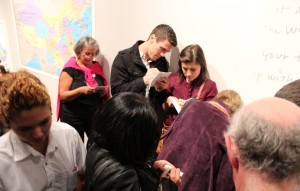 Many cultures have wishing trees, where believers make votive offerings in order to gain fulfillment of their wish. For example, there is a hawthorn tree in Argyll, Scotland where hundreds of coins have been hammered into the trunk and branches in hopes that wishes for fertility will be granted by the spirits or faeries associated with the tree.
Many cultures have wishing trees, where believers make votive offerings in order to gain fulfillment of their wish. For example, there is a hawthorn tree in Argyll, Scotland where hundreds of coins have been hammered into the trunk and branches in hopes that wishes for fertility will be granted by the spirits or faeries associated with the tree.  The practice of tying pieces of cloth to a wish tree is often directly associated with nearby clootie wells, as they are known in Scotland and Ireland. Locals and visitors in Hong Kong write wishes on joss paper, tie them to oranges and toss them into two banyan trees known as the Lam Tsuen Wishing Trees. Legend states that if the paper sticks to one of the branches, that wish will come true. In the Loch Lomond and the Trossachs National Park Centre Scotland, people ties their wishes for the environment to wish trees located there. In a related cultural tradition found in many places, including the United States, supplicants hurl shoes into trees that are locally designated as wellsprings of good fortune.
The practice of tying pieces of cloth to a wish tree is often directly associated with nearby clootie wells, as they are known in Scotland and Ireland. Locals and visitors in Hong Kong write wishes on joss paper, tie them to oranges and toss them into two banyan trees known as the Lam Tsuen Wishing Trees. Legend states that if the paper sticks to one of the branches, that wish will come true. In the Loch Lomond and the Trossachs National Park Centre Scotland, people ties their wishes for the environment to wish trees located there. In a related cultural tradition found in many places, including the United States, supplicants hurl shoes into trees that are locally designated as wellsprings of good fortune.
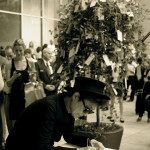 Not all of Ono’s Wish Trees are associated with larger exhibitions of her work. For example, a Wish Tree has been installed in the sculpture garden at New York’s Museum of Modern Art, with another being placed in the Hirshhorn Museum and Sculpture Garden in Washington D.C. But no matter where or why the Wish Tree appears, the wishes attached to their branches are destined for interment inside the base of the Imagine Peace Tower on Videy Island in Kollafjörður Bay near Reykjavík, Iceland.
Not all of Ono’s Wish Trees are associated with larger exhibitions of her work. For example, a Wish Tree has been installed in the sculpture garden at New York’s Museum of Modern Art, with another being placed in the Hirshhorn Museum and Sculpture Garden in Washington D.C. But no matter where or why the Wish Tree appears, the wishes attached to their branches are destined for interment inside the base of the Imagine Peace Tower on Videy Island in Kollafjörður Bay near Reykjavík, Iceland.
In the early days, Yoko collected the wishes herself and either took them or sent them on to Reykjavik. 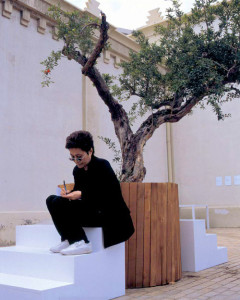 “I never read any of them,” she told Hans Ulrich Obrist in a 2002 interview. “I feel it’s not right to read people’s private wishes.” But now, she encourages curators and exhibitors to send their wishes directly to the Tower. In fact, the website she’s created for the tower provides both an email address (wish@imaginepeace.com) and post office box (IMAGINE PEACE TOWER, P.O.Box 1009, 121 Reykjavik, Iceland) for this very purpose.
“I never read any of them,” she told Hans Ulrich Obrist in a 2002 interview. “I feel it’s not right to read people’s private wishes.” But now, she encourages curators and exhibitors to send their wishes directly to the Tower. In fact, the website she’s created for the tower provides both an email address (wish@imaginepeace.com) and post office box (IMAGINE PEACE TOWER, P.O.Box 1009, 121 Reykjavik, Iceland) for this very purpose.
To date, the wishing-well base of the Imagine Peace Tower holds more than a million wishes from people across the globe, and the wishes collected during Yoko Ono Imagine Peace in Fort Myers will be added to them. 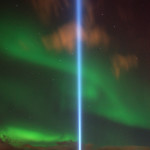 However, they won’t be mailed to shipped to Reykjavik. Funds are being raised on campus to send three Edison State College students to Reykjavik after the exhibit ends so that the wishes visitors attach to the Wish Trees during the course of the Rauschenberg Gallery exhibition can be hand delivered.
However, they won’t be mailed to shipped to Reykjavik. Funds are being raised on campus to send three Edison State College students to Reykjavik after the exhibit ends so that the wishes visitors attach to the Wish Trees during the course of the Rauschenberg Gallery exhibition can be hand delivered.
“I hope Imagine Peace Tower will give light to the strong wishes of World Peace from all corners of the planet and give encouragement, inspiration and a sense of solidarity in a world now filled with fear and confusion,” Yoko writes on the tower’s website. “Let us come together to realize a peaceful world.”
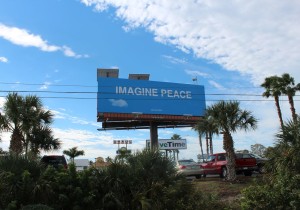 If you want your personal wish for peace to be included with those taken by the Edison State College delegation to Reyjkavik, you have until March 29 to visit Yoko Ono Imagine Peace at the Bob Rauschenberg Gallery on the Lee campus of Edison State College. During the exhibit, gallery hours are 10 a.m. to 4 p.m. Monday through Friday, and 11 a.m. to 3 p.m. on Saturday (closed Sundays and holidays). For more information, please telephone 239-489-9313.
If you want your personal wish for peace to be included with those taken by the Edison State College delegation to Reyjkavik, you have until March 29 to visit Yoko Ono Imagine Peace at the Bob Rauschenberg Gallery on the Lee campus of Edison State College. During the exhibit, gallery hours are 10 a.m. to 4 p.m. Monday through Friday, and 11 a.m. to 3 p.m. on Saturday (closed Sundays and holidays). For more information, please telephone 239-489-9313.
“All my works are a form of wishing,” notes the artist. “Keep wishing while you participate.”
______________________________________________________
Yoko Ono ‘Light House’ beguiles viewers, just as the concept captivated John Lennon 49 years ago (01-26-14)
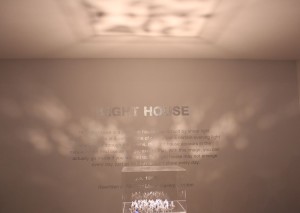 Yoko Ono Imagine Peace opened Friday night at the Bob Rauschenberg Gallery in Fort Myers. One of the more beguiling pieces in the exhibition is tucked away in an alcove in the back of the gallery. It is called Light House, and its progenitor was first offered for sale by Yoko Ono in 1965.
Yoko Ono Imagine Peace opened Friday night at the Bob Rauschenberg Gallery in Fort Myers. One of the more beguiling pieces in the exhibition is tucked away in an alcove in the back of the gallery. It is called Light House, and its progenitor was first offered for sale by Yoko Ono in 1965.
Of course, back then, Light House was purely conceptual, existing only in Yoko Ono’s fertile mind and wild imagination. She included it in her Conceptual “Sales List.” Some 200 copies of the catalog were mailed out to people who followed Ono’s art. John Lennon was a member of that select group.
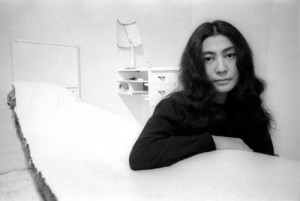 “In 1967, John Lennon invited me for lunch at his house, ‘Kenwood,’ in Surrey, England,” Ono recounts on imaginepeacetower.com. He told Ono that he’d read about Light House in her Sales List and wanted her to build one in his garden. “Oh, that was a conceptual light house!” Ono replied, bemused. “I’m convinced that one day, it could be built, but I don’t know how to do it,” she laughed. “I still marvel at the fact that John was touched by that particular concept in my catalog, and 40 years ago at that!”
“In 1967, John Lennon invited me for lunch at his house, ‘Kenwood,’ in Surrey, England,” Ono recounts on imaginepeacetower.com. He told Ono that he’d read about Light House in her Sales List and wanted her to build one in his garden. “Oh, that was a conceptual light house!” Ono replied, bemused. “I’m convinced that one day, it could be built, but I don’t know how to do it,” she laughed. “I still marvel at the fact that John was touched by that particular concept in my catalog, and 40 years ago at that!”
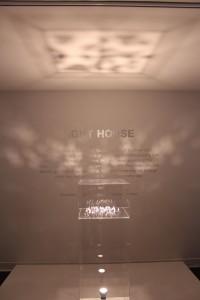 To appreciate Ono’s conceptual renderings, it’s helpful to use sheet music as a simile. “My work is like giving people scores – just like in music,” Ono told Rauschenberg Director Jade Dellinger in an email interview. “You can play any of the classic music by following the scores. My work is very similar to that.” In that vein, the wall behind the Rauschenberg installation provides the conceptual score, which she re-wrote more succinctly for her 1967 exhibition at the Lisson Gallery in London: “The light house is a phantom house that is built by sheer light. You set up prisms at a certain time of day, under a certain evening light which goes through the prisms, the light house appears in the middle of the field like an image, except that, with this image, you can actually go inside if you wanted to. The light house may not emerge every day, just as the sun doesn’t shine every day. Yoko Ono, 1965. Rewritten for Lisson Gallery, London, 1967.”
To appreciate Ono’s conceptual renderings, it’s helpful to use sheet music as a simile. “My work is like giving people scores – just like in music,” Ono told Rauschenberg Director Jade Dellinger in an email interview. “You can play any of the classic music by following the scores. My work is very similar to that.” In that vein, the wall behind the Rauschenberg installation provides the conceptual score, which she re-wrote more succinctly for her 1967 exhibition at the Lisson Gallery in London: “The light house is a phantom house that is built by sheer light. You set up prisms at a certain time of day, under a certain evening light which goes through the prisms, the light house appears in the middle of the field like an image, except that, with this image, you can actually go inside if you wanted to. The light house may not emerge every day, just as the sun doesn’t shine every day. Yoko Ono, 1965. Rewritten for Lisson Gallery, London, 1967.”
 Ono may have never figured out how to make a move-in ready light house, but she did find a way in 2006-7 to build a light tower that soars two and one-half miles into the sky on a clear Icelandic night. Called the Imagine Peace Tower, it can be found on Videy Island in Kollafjörður Bay near Reykjavík. It is conjured by 15 searchlights with prisms that act as mirrors, reflecting a column of light vertically into the sky from a 30-foot wide wishing well base. It uses roughly 75 kilowatts of power, supplied by Iceland’s unique geo-thermal energy grid, which was a big factor in Yoko choosing Iceland as the tower’s site.
Ono may have never figured out how to make a move-in ready light house, but she did find a way in 2006-7 to build a light tower that soars two and one-half miles into the sky on a clear Icelandic night. Called the Imagine Peace Tower, it can be found on Videy Island in Kollafjörður Bay near Reykjavík. It is conjured by 15 searchlights with prisms that act as mirrors, reflecting a column of light vertically into the sky from a 30-foot wide wishing well base. It uses roughly 75 kilowatts of power, supplied by Iceland’s unique geo-thermal energy grid, which was a big factor in Yoko choosing Iceland as the tower’s site.
 Yoko dedicated the tower to John. “[B]ecause that was the first work of mine that interested him,” she explains matter-of-factly in her Dellinger interview, which is available in full at the gallery. In addition to Ono, the October 9, 2007 dedication was attended by the couple’s son, Sean Lennon, Ringo Starr, George Harrison’s widow, Olivia, and George and Olivia’s son Dhani Harrison. (Paul McCartney but could not attend due to a court case.) Yoko Ono said at the ceremony that the tower was the best thing that she and John had ever done. “It is my work dedicated to John, expressing my gratitude and love to him,” she adds today.
Yoko dedicated the tower to John. “[B]ecause that was the first work of mine that interested him,” she explains matter-of-factly in her Dellinger interview, which is available in full at the gallery. In addition to Ono, the October 9, 2007 dedication was attended by the couple’s son, Sean Lennon, Ringo Starr, George Harrison’s widow, Olivia, and George and Olivia’s son Dhani Harrison. (Paul McCartney but could not attend due to a court case.) Yoko Ono said at the ceremony that the tower was the best thing that she and John had ever done. “It is my work dedicated to John, expressing my gratitude and love to him,” she adds today.
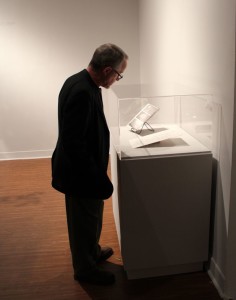 But Ono was not content to merely create a monument to her husband that radiates an eternal message of joy, wisdom, hope and healing . Buried beneath the tower are more than one million written wishes for peace that Ono has gathered over the years in conjunction with Wish Tree, her completely interactive conceptual work that is also included in the Rauschenberg exhibition. And written on the tower’s base in 24 languages are the words “Imagine Peace,” an abbreviated slogan that traces its origins to the “War Is Over! If You Want It” billboards that she and John erected in cities around the world during their successful Year of Peace campaign to end the war in Vietnam.
But Ono was not content to merely create a monument to her husband that radiates an eternal message of joy, wisdom, hope and healing . Buried beneath the tower are more than one million written wishes for peace that Ono has gathered over the years in conjunction with Wish Tree, her completely interactive conceptual work that is also included in the Rauschenberg exhibition. And written on the tower’s base in 24 languages are the words “Imagine Peace,” an abbreviated slogan that traces its origins to the “War Is Over! If You Want It” billboards that she and John erected in cities around the world during their successful Year of Peace campaign to end the war in Vietnam.
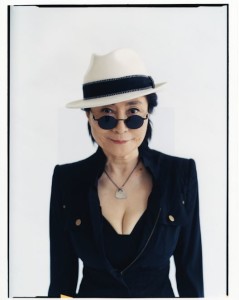 In comparison to the Imagine Peace Tower, Light House may seem tame to Yoko Ono Imagine Peace attendees. Perhaps. But if one uses their imagination, the light cast against the back wall and ceiling of the Rauschenberg Gallery by the array of prisms spread across the base of its vitrine case are no less transfixing. Yoko Ono Imagine Peace is on view now through March 29 at the Bob Rauschenberg Gallery on the Lee campus of Edison State College. During the exhibit, gallery hours are 10 a.m. to 4 p.m. Monday through Friday, and 11 a.m. to 3 p.m. on Saturday (closed Sundays and holidays). For more information, please telephone 239-489-9313.
In comparison to the Imagine Peace Tower, Light House may seem tame to Yoko Ono Imagine Peace attendees. Perhaps. But if one uses their imagination, the light cast against the back wall and ceiling of the Rauschenberg Gallery by the array of prisms spread across the base of its vitrine case are no less transfixing. Yoko Ono Imagine Peace is on view now through March 29 at the Bob Rauschenberg Gallery on the Lee campus of Edison State College. During the exhibit, gallery hours are 10 a.m. to 4 p.m. Monday through Friday, and 11 a.m. to 3 p.m. on Saturday (closed Sundays and holidays). For more information, please telephone 239-489-9313.
__________________________________________________________________
For conceptual artist Yoko Ono, thoughts are things (01-24-14)
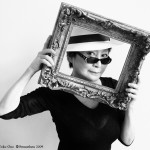 A few months after first meeting her, John Lennon tried to commission Yoko Ono to build a “light house” in his garden. “Oh that was conceptual,” Ono demurred, referring to a structure she’d built in her imagination with beams of refracted light emanating from hypothetical prisms. In the 47 years that have ensued since that conversation, Yoko Ono has constructed a legacy as the world’s penultimate conceptual artist.
A few months after first meeting her, John Lennon tried to commission Yoko Ono to build a “light house” in his garden. “Oh that was conceptual,” Ono demurred, referring to a structure she’d built in her imagination with beams of refracted light emanating from hypothetical prisms. In the 47 years that have ensued since that conversation, Yoko Ono has constructed a legacy as the world’s penultimate conceptual artist.
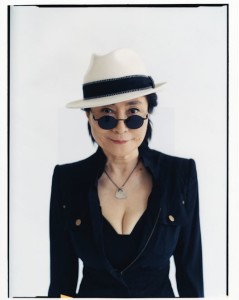 If Ono had her druthers, people entering the Bob Rauschenberg Gallery on January 24 to see Yoko Ono: Imagine Peace would be handed a set of instructions and asked to fill the exhibition hall’s blank walls with magnificent artworks projected from their individual and collective imaginations. YOIP does not go quite that far, but there will be no viewers or spectators at the exhibit. Everyone who passes through the Rauschenberg Gallery’s doors will be magically converted into an active collaborator the instant they are handed an Onochord and encounter works such as Wish Tree, Map Piece and Play It By Trust.
If Ono had her druthers, people entering the Bob Rauschenberg Gallery on January 24 to see Yoko Ono: Imagine Peace would be handed a set of instructions and asked to fill the exhibition hall’s blank walls with magnificent artworks projected from their individual and collective imaginations. YOIP does not go quite that far, but there will be no viewers or spectators at the exhibit. Everyone who passes through the Rauschenberg Gallery’s doors will be magically converted into an active collaborator the instant they are handed an Onochord and encounter works such as Wish Tree, Map Piece and Play It By Trust.
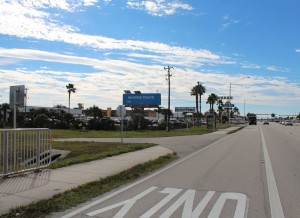 “I spend a lot of time in museums and never fail to be amazed at how people spend more time reading labels than looking at the art,” states co-curator Kevin Concannon, the Virginia Tech Director of Visual Arts who orchestrated the first YOIP exhibit in 2007 at the University of Akron in Ohio. “That doesn’t happen with Yoko’s participatory pieces. They induce an exchange between the audience and the artist.”
“I spend a lot of time in museums and never fail to be amazed at how people spend more time reading labels than looking at the art,” states co-curator Kevin Concannon, the Virginia Tech Director of Visual Arts who orchestrated the first YOIP exhibit in 2007 at the University of Akron in Ohio. “That doesn’t happen with Yoko’s participatory pieces. They induce an exchange between the audience and the artist.”
 While the manner in which each guest and audience make each new iteration of VOIP fresh and unique, the exhibition has been totally reconceived for the Rauschenberg Gallery. “It really is a ‘new’ exhibition, with everything except Play It By Trust being made site-specifically for our show,” notes new Rauschenberg Director Jade Dellinger. “We will include material related to Yoko’s Indica Gallery exhibition and her original ‘Sales List’ – which were never included in previous exhibitions and are being lent by Yoko’s Studio One in NYC.”
While the manner in which each guest and audience make each new iteration of VOIP fresh and unique, the exhibition has been totally reconceived for the Rauschenberg Gallery. “It really is a ‘new’ exhibition, with everything except Play It By Trust being made site-specifically for our show,” notes new Rauschenberg Director Jade Dellinger. “We will include material related to Yoko’s Indica Gallery exhibition and her original ‘Sales List’ – which were never included in previous exhibitions and are being lent by Yoko’s Studio One in NYC.”
Material from “John & Yoko’s Year of Peace” has also been eliminated, which serves to place the focus on Ono’s contributions as a conceptual artist.
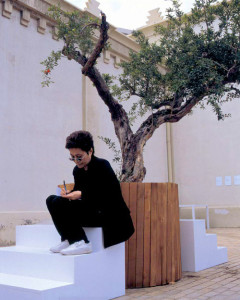 For Ono, thoughts are things. She is living testament to the affirmations mouthed by Napoleon Hill, Earl Nightingale and Brian Tracy that “what the mind can conceive, it will achieve with a positive mental attitude,” “you become what you think about” and “like attracts like in the realm of the mind.” She controls the images entering her own mind with Spartan-like self-discipline. That’s why all the negatively that has been hurled at her since her liaison with John Lennon has failed to derail either her creativity or message.
For Ono, thoughts are things. She is living testament to the affirmations mouthed by Napoleon Hill, Earl Nightingale and Brian Tracy that “what the mind can conceive, it will achieve with a positive mental attitude,” “you become what you think about” and “like attracts like in the realm of the mind.” She controls the images entering her own mind with Spartan-like self-discipline. That’s why all the negatively that has been hurled at her since her liaison with John Lennon has failed to derail either her creativity or message.
But Ono does not operate exclusively in the realm of the individual. The magic of Yoko Ono: Imagine Peace is that it works on the collective zeitgeist first of the audience, then of the surrounding community, and ultimately the entire world.
 Say “imagine peace” enough, and you will. Write your individual wish for peace on a tag and affix it to Ono’s Wish Tree, and you’ve converted thoughts into action. Hear that your wish has joined more than a million others at the Imagine Peace Tower in Iceland, and you will come to believe that peace is not just possible, but inevitable when enough energized people share that dream.
Say “imagine peace” enough, and you will. Write your individual wish for peace on a tag and affix it to Ono’s Wish Tree, and you’ve converted thoughts into action. Hear that your wish has joined more than a million others at the Imagine Peace Tower in Iceland, and you will come to believe that peace is not just possible, but inevitable when enough energized people share that dream.
“But peace can mean more than just the end of war,” notes Dellinger. “It can mean personal balance and well-being, harmony within your family or the end to gun violence.”
Ono alludes to this more expansive interpretation in a cut from her current album, Take Me to the Land of Hell. “We, the expendable people of the United States, ask for the violence to disappear …,” she implores in Cheshire Cat Cry. “Stop the violence. Stop all the wars. Who needs violence? Who needs war? Who needs it?” She feels this refrain so deeply that she published the lyrics in a full page ad in The New York Times last September.
But make no mistake. Ono is not prone to wishful thinking.
“The future is an infinite succession of presents, and to live now as we think human beings should live, in defiance of all that is bad around us, is itself a marvelous victory,” quotes Concannon from Ono’s favorite passage in a 2004 Howard Zinn article. And since you become what you think about, there’s everything to be gained by controlling your thoughts and attracting the future you want and deserve.
If those who attend the Bob Rauschenberg exhibit leave with that sense, with the conviction that they can change their lives and even our culture through the power of their imagination and a cognizance that we are all part of a universal scheme, then Concannon, co-curator John Noga, and Dellinger will have done their job, and Yoko herself will be thrilled.
“A dream you dream alone is only a dream,” Ono declared in her 1972 single, Now or Never, “but a dream we dream together is reality.” That’s as true today as it was then.
You can share that dream and become part of a new “gallery happening” on January 24 when Yoko Ono: Imagine Peace opens at the Bob Rauschenberg Gallery on the Lee campus of Edison State College. For more information, please telephone 239-489-9313.
________________________________________________
Co-curator Kevin Concannon brings Yoko Ono messages and insights to Fort Myers tomorrow night (01-23-14)
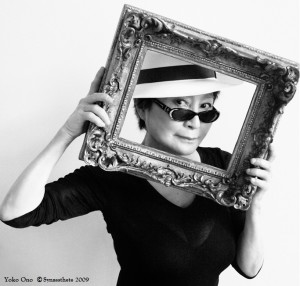 Tomorrow night, Yoko Ono Imagine Peace opens at the Bob Rauschenberg Gallery with a 6:00 p.m. Gallery Talk in the Rush Library Auditorium by co-curator Kevin Concannon. This is the eighth Ono exhibition that Concannon and partner John Noga have co-curated since 2007, but it promises to be vastly different than any of its predecessors.
Tomorrow night, Yoko Ono Imagine Peace opens at the Bob Rauschenberg Gallery with a 6:00 p.m. Gallery Talk in the Rush Library Auditorium by co-curator Kevin Concannon. This is the eighth Ono exhibition that Concannon and partner John Noga have co-curated since 2007, but it promises to be vastly different than any of its predecessors.
“I’ve been a huge Beatles fan since I was 12 years old,” copped Cancannon in a December telephone interview. 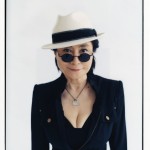 So he naturally took notice of Yoko Ono when she and John Lennon embarked upon a whirlwind romance in 1967 that had the pop world talking and the media in a frenzy. But unlike the hordes of Beatles fans who resented the liaison and blamed Ono for the band’s break up, Concannon was never a hater. “Yoko was the first artist I ever encountered in a visual way.” Like Lennon, Concannon regarded Ono as an artist with something meaningful to say. He became a fan of ’60s conceptual art and Ono’s unique role as one of its leading pioneers.
So he naturally took notice of Yoko Ono when she and John Lennon embarked upon a whirlwind romance in 1967 that had the pop world talking and the media in a frenzy. But unlike the hordes of Beatles fans who resented the liaison and blamed Ono for the band’s break up, Concannon was never a hater. “Yoko was the first artist I ever encountered in a visual way.” Like Lennon, Concannon regarded Ono as an artist with something meaningful to say. He became a fan of ’60s conceptual art and Ono’s unique role as one of its leading pioneers.
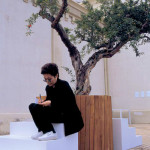 The two did not become acquainted until nearly 30 years later, when Concannon wrote the catalog for a 1996 exhibition of Yoko’s work at Virginia Commonwealth University. That led to an essay for YES Yoko Ono, a 2000 retrospective on Ono’s career. But seven more years would pass before Concannon and Noga organized their first exhibition of Ono’s avant-garde experimental and experiential art pieces.
The two did not become acquainted until nearly 30 years later, when Concannon wrote the catalog for a 1996 exhibition of Yoko’s work at Virginia Commonwealth University. That led to an essay for YES Yoko Ono, a 2000 retrospective on Ono’s career. But seven more years would pass before Concannon and Noga organized their first exhibition of Ono’s avant-garde experimental and experiential art pieces.
The show took place in the Emily Davis Gallery in the Myers School of Art at the University of Akron in Ohio. A cornerstone of that exhibit were 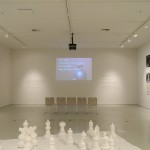 photographs from John and Yoko’s “Year of Peace,” including the bed-ins staged by the couple following their 1969 nuptials to ramp up popular support for ending the Vietnam War as well as billboards John and Yoko erected in cities around the world that read, “War is Over! If You Want It.” Neither the Year of Peace photos nor War is Over billboards are part of the Rauschenberg Gallery exhibition, although an Imagine Peace billboard announcing the show does grace the southbound lanes of Cleveland Avenue, just south of Page Field Commons.
photographs from John and Yoko’s “Year of Peace,” including the bed-ins staged by the couple following their 1969 nuptials to ramp up popular support for ending the Vietnam War as well as billboards John and Yoko erected in cities around the world that read, “War is Over! If You Want It.” Neither the Year of Peace photos nor War is Over billboards are part of the Rauschenberg Gallery exhibition, although an Imagine Peace billboard announcing the show does grace the southbound lanes of Cleveland Avenue, just south of Page Field Commons.
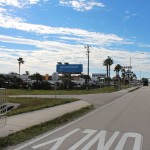 Subsequent presentations featured photographs, posters, advertisements, lithographs, interactive/participatory pieces and videos, including one showing Ono sitting on stage in a chair as members from the audience take turns using scissors to cut off pieces of her clothing, a metaphor susceptible of differing interpretations which range from the unfairness that women are required to endure in modern-day society to the freedom that only comes to those who prove willing to give up the pursuit of possessions and other materialistic goals.
Subsequent presentations featured photographs, posters, advertisements, lithographs, interactive/participatory pieces and videos, including one showing Ono sitting on stage in a chair as members from the audience take turns using scissors to cut off pieces of her clothing, a metaphor susceptible of differing interpretations which range from the unfairness that women are required to endure in modern-day society to the freedom that only comes to those who prove willing to give up the pursuit of possessions and other materialistic goals.
 “The exhibition at the Bob Rauschenberg Gallery is dramatically different from that first show,” Concannon acknowledges. New Rauschenberg Gallery Director Jade Dellinger goes so far as to say that it’s been “totally re-conceived and restructured” in collaboration with the artist “to reflect the Gallery’s mission and its role as a learning laboratory on the campus of Edison State College.” But Concannon and Dellinger are coy. They decline to elaborate on the ways the exhibition differs from the seminal show at Akron or even its latest iteration at the Taubman Museum of Art, which closed on January 11, 2014.
“The exhibition at the Bob Rauschenberg Gallery is dramatically different from that first show,” Concannon acknowledges. New Rauschenberg Gallery Director Jade Dellinger goes so far as to say that it’s been “totally re-conceived and restructured” in collaboration with the artist “to reflect the Gallery’s mission and its role as a learning laboratory on the campus of Edison State College.” But Concannon and Dellinger are coy. They decline to elaborate on the ways the exhibition differs from the seminal show at Akron or even its latest iteration at the Taubman Museum of Art, which closed on January 11, 2014.
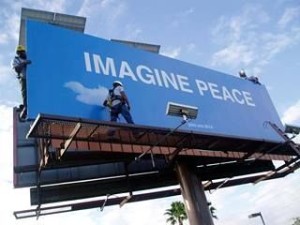 “John and I actually thought the Taubman exhibition would be our last,” Concannon discloses. But then Dellinger asked them if he could bring the exhibition to Fort Myers. “The show has a way of finding its audience,” Kevin demurs. “It has an important message. One that is, sadly, always timely. It’s a message that can’t be repeated enough.” And with conflicts still taking place all over the world, Ono is pleased that those who encounter her artworks seem eager to help spread her dual messages of peace and love. And to assist them in this endeavor in the days, weeks and months following tomorrow night’s evocative opening, Ono has provided at her own expense a supply of postcards, button and flashlights designed to involve attendees in the process of achieving inner and world peace through the power of their imagination.
“John and I actually thought the Taubman exhibition would be our last,” Concannon discloses. But then Dellinger asked them if he could bring the exhibition to Fort Myers. “The show has a way of finding its audience,” Kevin demurs. “It has an important message. One that is, sadly, always timely. It’s a message that can’t be repeated enough.” And with conflicts still taking place all over the world, Ono is pleased that those who encounter her artworks seem eager to help spread her dual messages of peace and love. And to assist them in this endeavor in the days, weeks and months following tomorrow night’s evocative opening, Ono has provided at her own expense a supply of postcards, button and flashlights designed to involve attendees in the process of achieving inner and world peace through the power of their imagination.
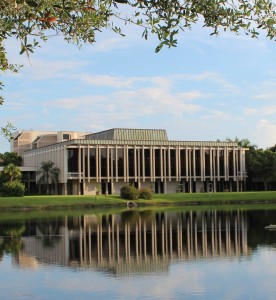 “Art and music open dialogues,” says Concannon. Which is goal of both the exhibition and the artist herself. “Yoko’s art is totally about communicating. She engages people through social media, but encourages [her more than 4 million followers on Twitter] to go out in the world and engage people one on one. There’s a huge difference between reading something in the news or a magazine and driving down the street and seeing an Imagine Peace billboard or coming to a place like the Bob Rauschenberg Gallery and getting swept up in Ono’s works along with everyone else.” Concannon knows first hand what that’s like. He got swept up in Yoko Ono’s cutting edge conceptual art more than 45 years ago, and learns something new with each exhibition because the audience’s reaction and interaction with the work makes each one completely unique.
“Art and music open dialogues,” says Concannon. Which is goal of both the exhibition and the artist herself. “Yoko’s art is totally about communicating. She engages people through social media, but encourages [her more than 4 million followers on Twitter] to go out in the world and engage people one on one. There’s a huge difference between reading something in the news or a magazine and driving down the street and seeing an Imagine Peace billboard or coming to a place like the Bob Rauschenberg Gallery and getting swept up in Ono’s works along with everyone else.” Concannon knows first hand what that’s like. He got swept up in Yoko Ono’s cutting edge conceptual art more than 45 years ago, and learns something new with each exhibition because the audience’s reaction and interaction with the work makes each one completely unique.
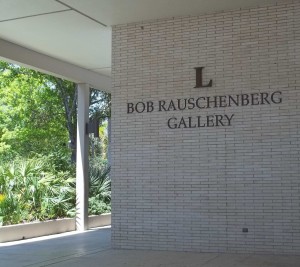 Those who turn out for tomorrow’s exhibition will certainly come to see Yoko Ono in a new light simply through the expediency of encountering her work first hand. But those who attend Kevin Concannon’s Gallery Talk will see both Ono, her work, and her legacy in a light informed by nearly five decades of research, thought and contemplation of the artist and her work, augmented by conversations with the artist on a host of far-flung topics (many of which he prefers to hold in confidence). It is an unparalleled opportunity to get into the mind of one of the world’s greatest conceptual artists through the eyes of an art professional who may very well know her better than anyone else save Ono herself.
Those who turn out for tomorrow’s exhibition will certainly come to see Yoko Ono in a new light simply through the expediency of encountering her work first hand. But those who attend Kevin Concannon’s Gallery Talk will see both Ono, her work, and her legacy in a light informed by nearly five decades of research, thought and contemplation of the artist and her work, augmented by conversations with the artist on a host of far-flung topics (many of which he prefers to hold in confidence). It is an unparalleled opportunity to get into the mind of one of the world’s greatest conceptual artists through the eyes of an art professional who may very well know her better than anyone else save Ono herself.
Yoko Ono Imagine Peace opens with Dr. Kevin Concannon’s Gallery Talk in the Rush Library Auditorium at 6 p.m. and a 7-9 p.m. reception inside the Bob Rauschenberg Gallery.
_______________________________________________
River Weekly story on Yoko Ono makes front page (01-10-14)
 Please pick up a copy of The River Weekly News. Yoko Ono Imagine Peace has made the front page of the publication. The article provides insight into the philosophy behind Ono’s conceptual art, particularly that which underlies pieces such as Wish Tree, Map Piece and Play It By Trust, which interestingly finds support in thinkers like Napoleon Hill, Brian Tracy and Earl Nightingale. It’s a must-read for anyone planning to attend the exhibition during its January 24-March 29 run, and may serve to induce you to include the exhibition on your schedule of events to attend if you are, for whatever reason, still on the fence.
Please pick up a copy of The River Weekly News. Yoko Ono Imagine Peace has made the front page of the publication. The article provides insight into the philosophy behind Ono’s conceptual art, particularly that which underlies pieces such as Wish Tree, Map Piece and Play It By Trust, which interestingly finds support in thinkers like Napoleon Hill, Brian Tracy and Earl Nightingale. It’s a must-read for anyone planning to attend the exhibition during its January 24-March 29 run, and may serve to induce you to include the exhibition on your schedule of events to attend if you are, for whatever reason, still on the fence.
___________________________________________________
Rauschenberg exhibit ‘Yoko Ono Imagine Peace’ nears opening (01-10-14)
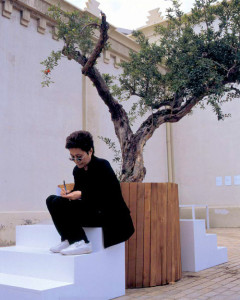 Among the earliest of artists working in the genre of Conceptual Art, Yoko Ono has consistently investigated the theme of peace and has invited those who interact with the work to play an active role in their creation and existence. The exhibition Yoko Ono Imagine Peace presents several of the artist’s most current works, re-imagined anew for the installation at the Bob Rauschenberg Gallery, Edison State College.
Among the earliest of artists working in the genre of Conceptual Art, Yoko Ono has consistently investigated the theme of peace and has invited those who interact with the work to play an active role in their creation and existence. The exhibition Yoko Ono Imagine Peace presents several of the artist’s most current works, re-imagined anew for the installation at the Bob Rauschenberg Gallery, Edison State College.
Four recent works, Wish Tree (1996/2014), Imagine Peace Maps (2003/2014), Onochord (2003/2014) and Imagine Peace Tower (2006/2014) offer gallery visitors an opportunity to participate individually and collectively with the artist in the realization of the work. 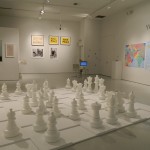 Passages of Light, a video that chronicles the conceptualization and construction of the Imagine Peace Tower, and reinterpretations of the works Parts of a Lighthouse and Mend Piece (for Fort Myers, Florida), are also featured in the exhibition. Play It By Trust, a monochrome chessboard and all white-painted lawn-sized game pieces, invites visitors to experience a playful metaphor for the futility and confusion of all types of conflict – where differentiation between opposing sides is difficult if not impossible to distinguish, and the commonality of opponents is exposed.
Passages of Light, a video that chronicles the conceptualization and construction of the Imagine Peace Tower, and reinterpretations of the works Parts of a Lighthouse and Mend Piece (for Fort Myers, Florida), are also featured in the exhibition. Play It By Trust, a monochrome chessboard and all white-painted lawn-sized game pieces, invites visitors to experience a playful metaphor for the futility and confusion of all types of conflict – where differentiation between opposing sides is difficult if not impossible to distinguish, and the commonality of opponents is exposed.
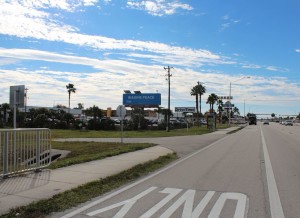 Yoko Ono Imagine Peace has been curated by Kevin Concannon and John Noga with the support and involvement of the artist. The installation at the Bob Rauschenberg Gallery is being configured in direct collaboration with Yoko Ono to reflect the Gallery’s mission and its role as a learning laboratory on the campus of Edison State College in Fort Myers, Florida.
Yoko Ono Imagine Peace has been curated by Kevin Concannon and John Noga with the support and involvement of the artist. The installation at the Bob Rauschenberg Gallery is being configured in direct collaboration with Yoko Ono to reflect the Gallery’s mission and its role as a learning laboratory on the campus of Edison State College in Fort Myers, Florida.
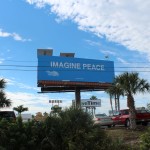 The Bob Rauschenberg Gallery was founded as The Gallery of Fine Art in 1979 on the Lee County campus of Edison State College (then Edison Community College). The Gallery of Fine Art was renamed the Bob Rauschenberg Gallery on June 4, 2004 to honor and commemorate its long time association and friendship with the artist.
The Bob Rauschenberg Gallery was founded as The Gallery of Fine Art in 1979 on the Lee County campus of Edison State College (then Edison Community College). The Gallery of Fine Art was renamed the Bob Rauschenberg Gallery on June 4, 2004 to honor and commemorate its long time association and friendship with the artist.
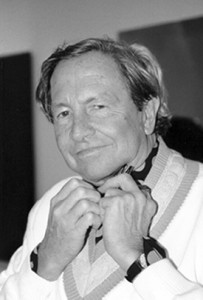 During the three decades preceding his death, Rauschenberg worked closely with the Gallery to present world premiere exhibitions including multiple installations of the ¼ Mile or Two Furlong Piece. The artist insisted on naming the space the Bob Rauschenberg Gallery (versus the “Robert Rauschenberg Gallery”) as was consistent with the intimate, informal relationship he maintained with both the local Southwest Florida community and Edison State College.
During the three decades preceding his death, Rauschenberg worked closely with the Gallery to present world premiere exhibitions including multiple installations of the ¼ Mile or Two Furlong Piece. The artist insisted on naming the space the Bob Rauschenberg Gallery (versus the “Robert Rauschenberg Gallery”) as was consistent with the intimate, informal relationship he maintained with both the local Southwest Florida community and Edison State College.
Gallery exhibitions are sponsored in part by the National Endowment for the Arts, The State of Florida, Department of Cultural Affairs and the Florida Arts Council. Yoko Ono Imagine Peace is generously underwritten by Trevett Capital Partners, Steven Hubbard and Carolann Swanson, Barbara Yeomans, Pottinger’s Nursery & Landscaping, and the Bob Rauschenberg Gallery Docent Helping Hand Fund.
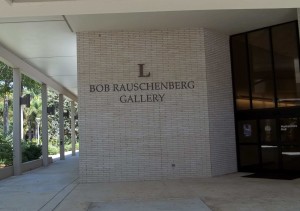 The exhibition opens on Friday, January 24 with a a Gallery Talk by co-curator Kevin Concannon in the Rush Auditorium in Building J that starts at 6:00 p.m. and reception from 7:00-9:00 p.m. The exhibition will continue through March 29, 2014. The gallery is open from 10:00 a.m. to 4:00 p.m. Monday through Friday, and 10:00 a.m. to 4:00 p.m. on Saturdays. For additional information, please call: (239) 489-9313 or visit www.RauschenbergGallery.com.
The exhibition opens on Friday, January 24 with a a Gallery Talk by co-curator Kevin Concannon in the Rush Auditorium in Building J that starts at 6:00 p.m. and reception from 7:00-9:00 p.m. The exhibition will continue through March 29, 2014. The gallery is open from 10:00 a.m. to 4:00 p.m. Monday through Friday, and 10:00 a.m. to 4:00 p.m. on Saturdays. For additional information, please call: (239) 489-9313 or visit www.RauschenbergGallery.com.
______________________________________________
Some 45 years after John and Yoko’s Year of Peace, Fort Myers gets its own ‘Imagine Peace’ billboard (01-04-14)
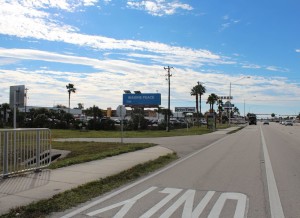 After their marriage in 1969, Yoko Ono and John Lennon embarked upon a Year of Peace that featured “bed-ins” and billboards erected in cities around the world that read “War is Over! If You Want It,” which they later simplified to “Imagine Peace.” Fort Myers wasn’t one of the towns where Yoko and John stopped. But 45 years later, Fort Myers finally has its very own Imagine Peace billboard, and in addition to peace, it touts the coming Yoko Ono Imagine Peace interactive art exhibition, which opens January 24 at the Bob Rauschenberg Gallery on the Lee campus of Edison State College.
After their marriage in 1969, Yoko Ono and John Lennon embarked upon a Year of Peace that featured “bed-ins” and billboards erected in cities around the world that read “War is Over! If You Want It,” which they later simplified to “Imagine Peace.” Fort Myers wasn’t one of the towns where Yoko and John stopped. But 45 years later, Fort Myers finally has its very own Imagine Peace billboard, and in addition to peace, it touts the coming Yoko Ono Imagine Peace interactive art exhibition, which opens January 24 at the Bob Rauschenberg Gallery on the Lee campus of Edison State College.
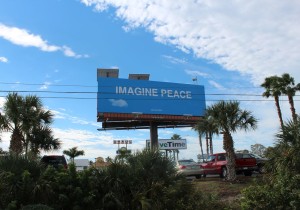 The Rauschenberg exhibit promises to be a gallery happening. That’s the nature of Ono’s conceptual art. Every piece is infused with highly participatory, viscerally interactive, theatrical content that induces visitors to not only connect with the art, but with each other as well. And that’s part of Ono’s artistic message. Each of us is interconnected through the power of our imagination with each other and a higher universal scheme. Whether you label it cosmic law or something more religious does not matter. What’s important to Ono is that the people who come to Yoko Ono Imagine Peace get to experience that interconnectedness.
The Rauschenberg exhibit promises to be a gallery happening. That’s the nature of Ono’s conceptual art. Every piece is infused with highly participatory, viscerally interactive, theatrical content that induces visitors to not only connect with the art, but with each other as well. And that’s part of Ono’s artistic message. Each of us is interconnected through the power of our imagination with each other and a higher universal scheme. Whether you label it cosmic law or something more religious does not matter. What’s important to Ono is that the people who come to Yoko Ono Imagine Peace get to experience that interconnectedness.
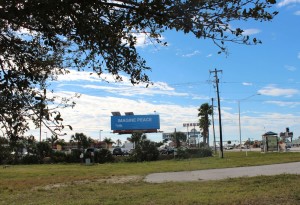 But for that magic to work, people first need to hear about the exhibition and become intrigued or excited enough to come. Which, of course, is the chief purpose of the billboard on the east side of Cleveland Avenue right next to Drive Time Used Cars. Two words. Twelve letters. Framed against a clear cerulean blue background that’s just a touch darker than the Southwest Florida blue skies. But the billboard doesn’t mention the exhibit. It doesn’t say anything about the Bob Rauschenberg Gallery. It simply invites commuters to Imagine Peace. Word of mouth, articles in newspapers and magazines, grassroots initiatives by local artists and Google Search will do the rest.
But for that magic to work, people first need to hear about the exhibition and become intrigued or excited enough to come. Which, of course, is the chief purpose of the billboard on the east side of Cleveland Avenue right next to Drive Time Used Cars. Two words. Twelve letters. Framed against a clear cerulean blue background that’s just a touch darker than the Southwest Florida blue skies. But the billboard doesn’t mention the exhibit. It doesn’t say anything about the Bob Rauschenberg Gallery. It simply invites commuters to Imagine Peace. Word of mouth, articles in newspapers and magazines, grassroots initiatives by local artists and Google Search will do the rest.
 But the slogan will work on each viewer on both a conscious and subconscious level. What would it be like not having to hear the news, oh boy, about more soldiers and civilians being maimed or killed in Afghanistan? Or a vet with PTSD taking his own life? Or the life of someone else. And dare we imagine peace from gun violence, economic oppression or the lack of effective health care?
But the slogan will work on each viewer on both a conscious and subconscious level. What would it be like not having to hear the news, oh boy, about more soldiers and civilians being maimed or killed in Afghanistan? Or a vet with PTSD taking his own life? Or the life of someone else. And dare we imagine peace from gun violence, economic oppression or the lack of effective health care?
That’s the beauty of conceptual art like Yoko Ono’s. She cedes control to you. You – and the people you view her art with – get to decide what you see,, how you feel and what you take away from each individual piece and the exhibition as a whole.
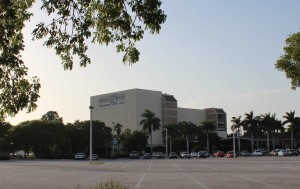 Yoko Ono Imagine Peace is curated by Kevin Concannon and John Noga with the support and involvement of the artist. The installation at the Bob Rauschenberg Gallery has been configured in collaboration with Yoko Ono to reflect the Gallery’s mission and role as a learning laboratory on the campus of Edison State College in Fort Myers, Florida. The exhibition opens at 5:00 p.m. on Friday, January 24, with a Gallery Talk by co-curator Kevin Concannon scheduled for 6:00 p.m. in the Rush Auditorium in Building J.
Yoko Ono Imagine Peace is curated by Kevin Concannon and John Noga with the support and involvement of the artist. The installation at the Bob Rauschenberg Gallery has been configured in collaboration with Yoko Ono to reflect the Gallery’s mission and role as a learning laboratory on the campus of Edison State College in Fort Myers, Florida. The exhibition opens at 5:00 p.m. on Friday, January 24, with a Gallery Talk by co-curator Kevin Concannon scheduled for 6:00 p.m. in the Rush Auditorium in Building J.
______________________________________________________
Yoko Ono Imagine Peace features work by one of world’s leading conceptual artists (01-04-14)
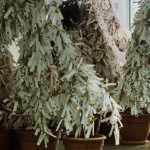 Even today, Ono is known by most as the musician wife and widow of former Beatle John Lennon. But long before she met Lennon or formed the Plastic Ono Band, Ono had established herself as one of the leading artists in the genre of Conceptual Art. And it is her conceptual artwork that will be presented to Southwest Florida by Yoko Ono Imagine Peace, an avant garde exhibition of several of the artist’s most current works, including Wish Tree (1996/2014), Imagine Peace Maps (2003/2014); Onochord (2003/2014); and Imagine Peace Tower (2006/2014).
Even today, Ono is known by most as the musician wife and widow of former Beatle John Lennon. But long before she met Lennon or formed the Plastic Ono Band, Ono had established herself as one of the leading artists in the genre of Conceptual Art. And it is her conceptual artwork that will be presented to Southwest Florida by Yoko Ono Imagine Peace, an avant garde exhibition of several of the artist’s most current works, including Wish Tree (1996/2014), Imagine Peace Maps (2003/2014); Onochord (2003/2014); and Imagine Peace Tower (2006/2014). 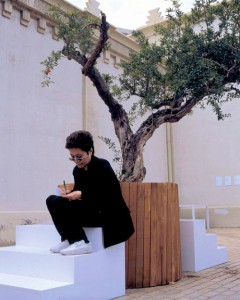 As the dates suggest, each of these pieces has been re-imagined anew for their installation inside the Bob Rauschenberg Gallery. Each artwork affords gallery visitors an unparalleled opportunity to participate individually and collectively with the artist in the realization of her work.
As the dates suggest, each of these pieces has been re-imagined anew for their installation inside the Bob Rauschenberg Gallery. Each artwork affords gallery visitors an unparalleled opportunity to participate individually and collectively with the artist in the realization of her work.
“Consider the world with fresh eyes as you stamp the phrase ‘Imagine Peace’ on the map location of your choice,” importunes new Rauschenberg Gallery Director Jade Dellinger via a recent post on Facebook. “Attach your handwritten wish for peace to the Wish Tree, and this wish will be delivered to the Imagine Peace Tower in Reykjavik, Iceland, where it will shine on eternally, joining more than a million others previously collected. You are also welcomed to beam the message “I Love You” to one and all using the Onochord flashlights. You may take an Onochord flashlight and an Imagine Peace button as a gift to you from the artist and carry these timeless messages out into the world. As Yoko Ono has often observed: ‘A dream you dream alone is just a dream, but a dream we dream together is reality.’”
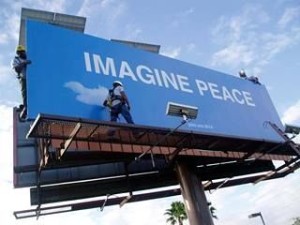 The billboard on Cleveland does more than just advertise the upcoming exhibition. It implicitly encourages those who see it to take up the cause and create their own variations and permutations on this theme. The billboards harken back in time to the massive, worldwide “War Is Over! (If You Want It)” campaign that Ono and Lennon successfully employed in the late ’60s and early ’70s to promote their views. Since Yoko Ono Imagine Peace was first presented in 2007, Imagine Peace billboards, signs, placards and ads have cropped everywhere Yoko Ono Imagine Peace has gone on exhibit, helping convert the exhibition from a mere art show into a “gallery happening.”
The billboard on Cleveland does more than just advertise the upcoming exhibition. It implicitly encourages those who see it to take up the cause and create their own variations and permutations on this theme. The billboards harken back in time to the massive, worldwide “War Is Over! (If You Want It)” campaign that Ono and Lennon successfully employed in the late ’60s and early ’70s to promote their views. Since Yoko Ono Imagine Peace was first presented in 2007, Imagine Peace billboards, signs, placards and ads have cropped everywhere Yoko Ono Imagine Peace has gone on exhibit, helping convert the exhibition from a mere art show into a “gallery happening.”
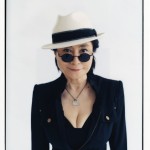 Kevin Concannon and John Noga have co-curated the exhibition with the support and involvement of the artist. The installation at the Bob Rauschenberg Gallery has been configured in direct collaboration with Yoko Ono to reflect the Gallery’s mission and its role as a learning laboratory on the campus of Edison State College in Fort Myers, Florida.
Kevin Concannon and John Noga have co-curated the exhibition with the support and involvement of the artist. The installation at the Bob Rauschenberg Gallery has been configured in direct collaboration with Yoko Ono to reflect the Gallery’s mission and its role as a learning laboratory on the campus of Edison State College in Fort Myers, Florida.
The Bob Rauschenberg Gallery was founded as The Gallery of Fine Art in 1979 on the Lee County campus of Edison State College (then Edison Community College). 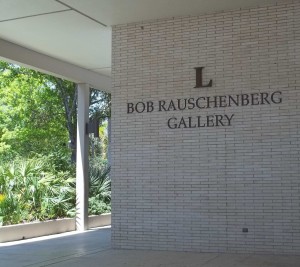 The gallery was renamed on June 4, 2004 as the Bob Rauschenberg Gallery to honor and commemorate its long association and friendship with the artist. During the three decades preceding his death in 2008, the Gallery worked closely with Rauschenberg to present world premiere exhibitions including multiple installations of the ¼ Mile or Two Furlong Piece. The artist insisted on naming the space the Bob Rauschenberg Gallery (versus the “Robert Rauschenberg Gallery”) to symbolize and memorialize the intimate, informal relationship he maintained with both the Southwest Florida community and Edison State College.
The gallery was renamed on June 4, 2004 as the Bob Rauschenberg Gallery to honor and commemorate its long association and friendship with the artist. During the three decades preceding his death in 2008, the Gallery worked closely with Rauschenberg to present world premiere exhibitions including multiple installations of the ¼ Mile or Two Furlong Piece. The artist insisted on naming the space the Bob Rauschenberg Gallery (versus the “Robert Rauschenberg Gallery”) to symbolize and memorialize the intimate, informal relationship he maintained with both the Southwest Florida community and Edison State College.
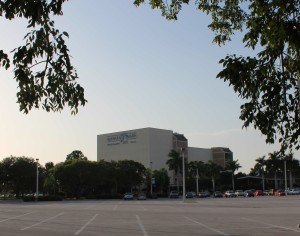 Gallery exhibitions are sponsored in part by the National Endowment for the Arts, The State of Florida, Department of Cultural Affairs and the Florida Arts Council. Yoko Ono Imagine Peace is generously underwritten by Trevett Capital Partners, Steven Hubbard and Carolann Swanson, Barbara Yeomans, and the Bob Rauschenberg Gallery Docent Helping Hand Fund.
Gallery exhibitions are sponsored in part by the National Endowment for the Arts, The State of Florida, Department of Cultural Affairs and the Florida Arts Council. Yoko Ono Imagine Peace is generously underwritten by Trevett Capital Partners, Steven Hubbard and Carolann Swanson, Barbara Yeomans, and the Bob Rauschenberg Gallery Docent Helping Hand Fund.
_________________________________________
‘Yoko Ono Imagine Peace’ to be first Bob Rauschenberg Gallery exhibit in Jade Dellinger era (12-10-13)
 Work by Yoko Ono is coming to Fort Myers. Re-imagined anew for the first exhibit of Jade Dellinger’s tenure as new Director and Curator of the Bob Rauschenberg Gallery, Yoko Ono Imagine Peace will reintroduce several of the artist’s most current works.
Work by Yoko Ono is coming to Fort Myers. Re-imagined anew for the first exhibit of Jade Dellinger’s tenure as new Director and Curator of the Bob Rauschenberg Gallery, Yoko Ono Imagine Peace will reintroduce several of the artist’s most current works.
“Long before she emerged into popular awareness as John Lennon’s wife, Yoko Ono had established herself in vanguard art and music circles as one of the most daring, innovative and eccentric artist-performers of her time,” writes art critic Peter Frank. “As one of the founders of the Fluxus movement at the beginning of the 1960s, Ono helped identify and define the playful, subversive, visionary sensibility that has undergirded experimentation in all the arts ever since.”
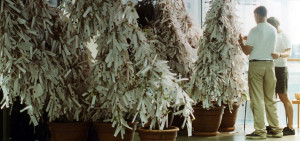 Over the course of her artistic career, Ono has consistently investigated the theme of peace and has invited those who interact with her work to play an active role in their creation and existence. Works like WISH TREE (1996/2014), IMAGINE PEACE MAPS (2003/2014), ONOCHORD (2003/2014) and IMAGINE PEACE TOWER (2006/2014) offer gallery visitors an opportunity to participate individually and collectively with the artist in the realization of each work.
Over the course of her artistic career, Ono has consistently investigated the theme of peace and has invited those who interact with her work to play an active role in their creation and existence. Works like WISH TREE (1996/2014), IMAGINE PEACE MAPS (2003/2014), ONOCHORD (2003/2014) and IMAGINE PEACE TOWER (2006/2014) offer gallery visitors an opportunity to participate individually and collectively with the artist in the realization of each work.
 The WISH TREE has been included in museum and cultural center exhibitions around the globe since 1981. At each venue, viewers are encouraged to write their personal wish for peace on a sliver of paper or shipping tag and tie them to the branch of the tree. They are added to the IMAGINE PEACE TOWER in Reykjavik, Iceland. Ono doesn’t read them, as she feels it is not right to read people’s private wishes, but by including them in a single totem-like sculpture, Ono expects their cumulative emotive message to engender a universal consciousness for world peace.
The WISH TREE has been included in museum and cultural center exhibitions around the globe since 1981. At each venue, viewers are encouraged to write their personal wish for peace on a sliver of paper or shipping tag and tie them to the branch of the tree. They are added to the IMAGINE PEACE TOWER in Reykjavik, Iceland. Ono doesn’t read them, as she feels it is not right to read people’s private wishes, but by including them in a single totem-like sculpture, Ono expects their cumulative emotive message to engender a universal consciousness for world peace.
“As a child in Japan, I used to go to a temple and write out a wish on a piece of thin paper and tie it around the branch of a tree,” Ono once explained of the project. “Trees in temple courtyards were always filled with people’s wish knots, which looked like white flowers blossoming from afar. All my works are a form of wishing.”
Ono relit the IMAGINE PEACE TOWER in memory of her husband on October 9 (the anniversary of John’s birth) and had it illuminated each night between 8 p.m. and midnight until December 8 (the 33rd anniversary of his death). She intends to turn the IMAGINE PEACE TOWER back on between December 21 and New Year’s Eve, on February 18 (her own birthday) and from February 21 to March 18, 2014.
“Please ask all your friends to join us by Tweeting wishes to IMAGINE PEACE TOWER (@IPTower), which you can do at IMAGINEPEACETOWER.com (the Tweet box is top right),” wrote Ono in announcing the initiative. “You can also send wishes by post, email & Facebook. Tell all your friends. Spread the word!”
Opening January 24, the exhibition at the Bob Rauschenberg Gallery will enable area residents and visitors to consider the world with fresh eyes as they stamp the phrase “Imagine Peace” on the IMAGINE PEACE MAP location of their choice, attach their own handwritten wish for peace to the WISH TREE, and have their wish delivered to the IMAGINE PEACE TOWER in Reykjavik, where it will shine on eternally, joining more than a million others previously collected.
“You are also welcomed to beam the message ‘I Love You’ to one and all using ONOCHORD flashlights,” states the Gallery in the press release announcing the exhibition. “You may take an ONOCHORD flashlight and an IMAGINE PEACE button as a gift to you from the artist and carry these timeless messages out into the world.”
As Yoko Ono has often observed, “A dream you dream alone is just a dream, but a dream we dream together is reality.”
Passages of Light, a video that chronicles the conceptualization and construction of the IMAGINE PEACE TOWER, and reinterpretations of the works Parts of a Lighthouse and Mend Piece, will also be featured in the exhibition. Play it by Trust, a monochrome chessboard and all-white painted lawn-sized game pieces, will invite visitors to experience a playful metaphor for the futility and confusion of all types of conflict – where differentiation between opposing sides is difficult if not impossible and the commonality of opponents is exposed.
The exhibition YOKO ONO IMAGINE PEACE is curated by Kevin Concannon and John Noga with the support and involvement of the artist. The installation at the Bob Rauschenberg Gallery has been configured in direct collaboration with Yoko Ono to reflect the Gallery’s mission and its role as a learning laboratory on the campus of Edison State College in Fort Myers, Florida.
 The Bob Rauschenberg Gallery was founded as The Gallery of Fine Art in 1979 on the Lee County campus of Edison State College (then Edison Community College). On June 4, 2004 the Gallery of Fine Art was renamed the Bob Rauschenberg Gallery to honor and commemorate the college’s long-time association and friendship with the artist. Over more than three decades until his death, the Gallery worked closely with Rauschenberg to present world premiere exhibitions including multiple installations of the ¼ Mile or Two Furlong Piece. The artist insisted on naming the space the Bob Rauschenberg Gallery (versus the “Robert Rauschenberg Gallery”) as it was consistent with the intimate, informal relationship he maintained with both the local Southwest Florida community and Edison State College.
The Bob Rauschenberg Gallery was founded as The Gallery of Fine Art in 1979 on the Lee County campus of Edison State College (then Edison Community College). On June 4, 2004 the Gallery of Fine Art was renamed the Bob Rauschenberg Gallery to honor and commemorate the college’s long-time association and friendship with the artist. Over more than three decades until his death, the Gallery worked closely with Rauschenberg to present world premiere exhibitions including multiple installations of the ¼ Mile or Two Furlong Piece. The artist insisted on naming the space the Bob Rauschenberg Gallery (versus the “Robert Rauschenberg Gallery”) as it was consistent with the intimate, informal relationship he maintained with both the local Southwest Florida community and Edison State College.
Gallery exhibitions are sponsored in part by the National Endowment for the Arts, The State of Florida, Department of Cultural Affairs and the Florida Arts Council. Yoko Ono Imagine Peace is generously underwritten by Trevett Capital Partners, Steven Hubbard and Carolann Swanson, Barbara Yeomans, and the Bob Rauschenberg Gallery Docent Helping Hand Fund.














 Tom Hall is both an amateur artist and aspiring novelist who writes art quest thrillers. He is in the final stages of completing his debut novel titled "Art Detective," a story that fictionalizes the discovery of the fabled billion-dollar Impressionist collection of Parisian art dealer Josse Bernheim-Jeune, thought by many to have perished during World War II when the collection's hiding place, Castle de Rastignac in southern France, was destroyed by the Wehrmacht in reprisal for attacks made by members of the Resistance operating in the area. A former tax attorney, Tom holds a bachelor's degree as well as both a juris doctorate and masters of laws in taxation from the University of Florida. Tom lives in Estero, Florida with his fiancee, Connie, and their four cats.
Tom Hall is both an amateur artist and aspiring novelist who writes art quest thrillers. He is in the final stages of completing his debut novel titled "Art Detective," a story that fictionalizes the discovery of the fabled billion-dollar Impressionist collection of Parisian art dealer Josse Bernheim-Jeune, thought by many to have perished during World War II when the collection's hiding place, Castle de Rastignac in southern France, was destroyed by the Wehrmacht in reprisal for attacks made by members of the Resistance operating in the area. A former tax attorney, Tom holds a bachelor's degree as well as both a juris doctorate and masters of laws in taxation from the University of Florida. Tom lives in Estero, Florida with his fiancee, Connie, and their four cats.